Archiv der Kategorie: IoT
Enhancing Drone Navigation with AI and IDS uEye Camera Technology
AI-driven drone from University of Klagenfurt uses IDS uEye camera for real-time, object-relative navigation—enabling safer, more efficient, and precise inspections.
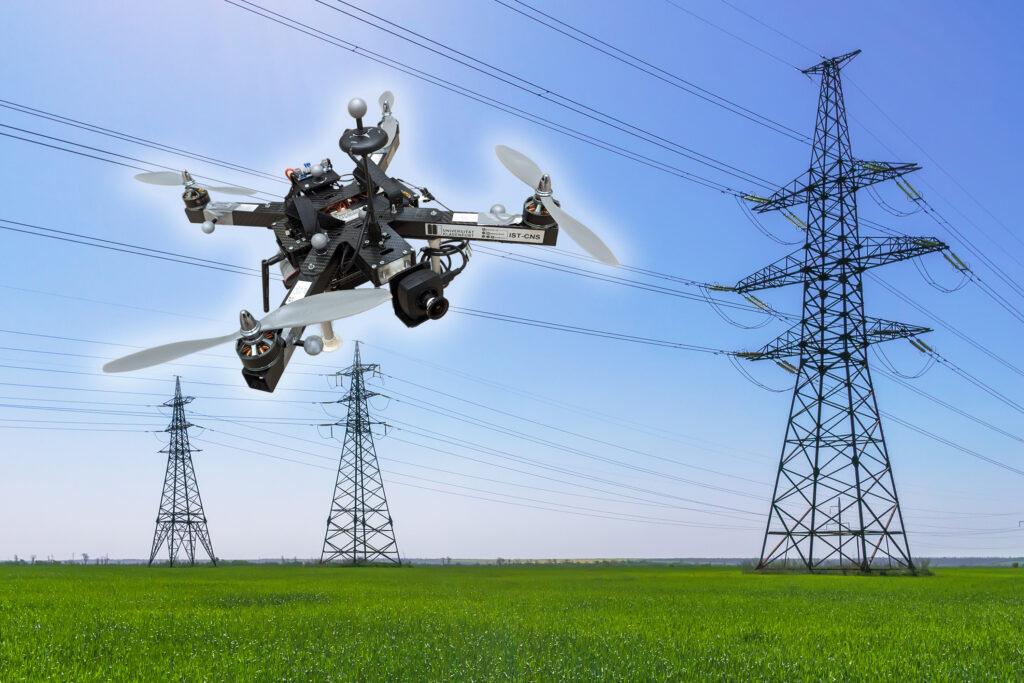
The inspection of critical infrastructures such as energy plants, bridges or industrial complexes is essential to ensure their safety, reliability and long-term functionality. Traditional inspection methods always require the use of people in areas that are difficult to access or risky. Autonomous mobile robots offer great potential for making inspections more efficient, safer and more accurate. Uncrewed aerial vehicles (UAVs) such as drones in particular have become established as promising platforms, as they can be used flexibly and can even reach areas that are difficult to access from the air. One of the biggest challenges here is to navigate the drone precisely relative to the objects to be inspected in order to reliably capture high-resolution image data or other sensor data.
A research group at the University of Klagenfurt has designed a real-time capable drone based on object-relative navigation using artificial intelligence. Also on board: a USB3 Vision industrial camera from the uEye LE family from IDS Imaging Development Systems GmbH.
As part of the research project, which was funded by the Austrian Federal Ministry for Climate Action, Environment, Energy, Mobility, Innovation and Technology (BMK), the drone must autonomously recognise what is a power pole and what is an insulator on the power pole. It will fly around the insulator at a distance of three meters and take pictures. „Precise localisation is important such that the camera recordings can also be compared across multiple inspection flights,“ explains Thomas Georg Jantos, PhD student and member of the Control of Networked Systems research group at the University of Klagenfurt. The prerequisite for this is that object-relative navigation must be able to extract so-called semantic information about the objects in question from the raw sensory data captured by the camera. Semantic information makes raw data, in this case the camera images, „understandable“ and makes it possible not only to capture the environment, but also to correctly identify and localise relevant objects.
In this case, this means that an image pixel is not only understood as an independent colour value (e.g. RGB value), but as part of an object, e.g. an isolator. In contrast to classic GNNS (Global Navigation Satellite System), this approach not only provides a position in space, but also a precise relative position and orientation with respect to the object to be inspected (e.g. „Drone is located 1.5m to the left of the upper insulator“).
The key requirement is that image processing and data interpretation must be latency-free so that the drone can adapt its navigation and interaction to the specific conditions and requirements of the inspection task in real time.
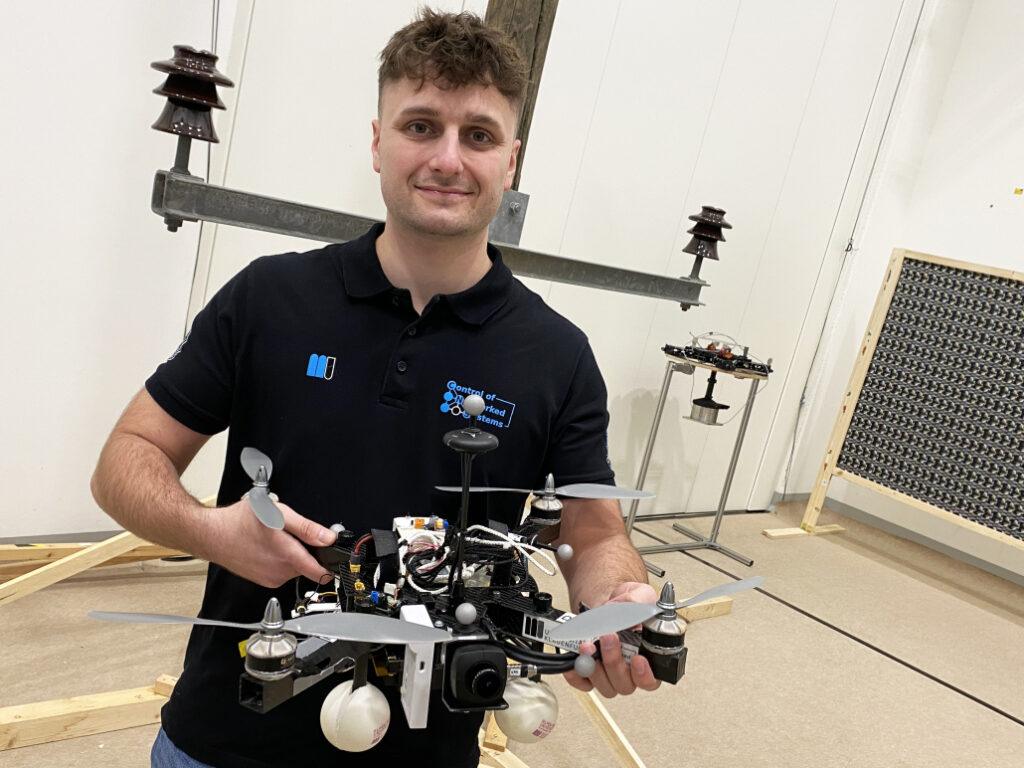
Semantic information through intelligent image processing
Object recognition, object classification and object pose estimation are performed using artificial intelligence in image processing. „In contrast to GNSS-based inspection approaches using drones, our AI with its semantic information enables the inspection of the infrastructure to be inspected from certain reproducible viewpoints,“ explains Thomas Jantos. „In addition, the chosen approach does not suffer from the usual GNSS problems such as multi-pathing and shadowing caused by large infrastructures or valleys, which can lead to signal degradation and thus to safety risks.“
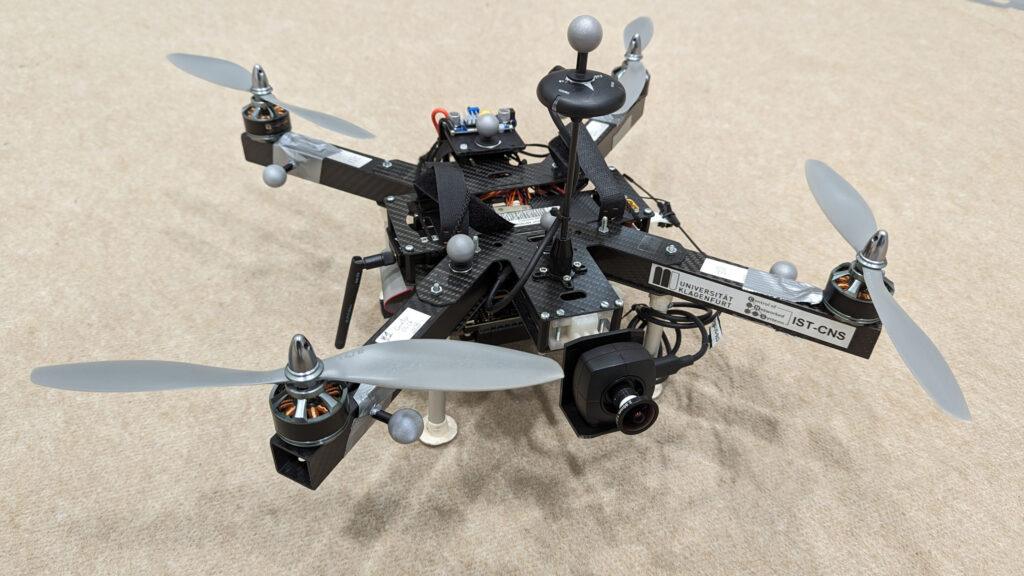
How much AI fits into a small quadcopter?
The hardware setup consists of a TWINs Science Copter platform equipped with a Pixhawk PX4 autopilot, an NVIDIA Jetson Orin AGX 64GB DevKit as on-board computer and a USB3 Vision industrial camera from IDS. „The challenge is to get the artificial intelligence onto the small helicopters.
The computers on the drone are still too slow compared to the computers used to train the AI. With the first successful tests, this is still the subject of current research,“ says Thomas Jantos, describing the problem of further optimising the high-performance AI model for use on the on-board computer.
The camera, on the other hand, delivers perfect basic data straight away, as the tests in the university’s own drone hall show. When selecting a suitable camera model, it was not just a question of meeting the requirements in terms of speed, size, protection class and, last but not least, price. „The camera’s capabilities are essential for the inspection system’s innovative AI-based navigation algorithm,“ says Thomas Jantos. He opted for the U3-3276LE C-HQ model, a space-saving and cost-effective project camera from the uEye LE family. The integrated Sony Pregius IMX265 sensor is probably the best CMOS image sensor in the 3 MP class and enables a resolution of 3.19 megapixels (2064 x 1544 px) with a frame rate of up to 58.0 fps. The integrated 1/1.8″ global shutter, which does not produce any ‚distorted‘ images at these short exposure times compared to a rolling shutter, is decisive for the performance of the sensor. „To ensure a safe and robust inspection flight, high image quality and frame rates are essential,“ Thomas Jantos emphasises. As a navigation camera, the uEye LE provides the embedded AI with the comprehensive image data that the on-board computer needs to calculate the relative position and orientation with respect to the object to be inspected. Based on this information, the drone is able to correct its pose in real time.
The IDS camera is connected to the on-board computer via a USB3 interface. „With the help of the IDS peak SDK, we can integrate the camera and its functionalities very easily into the ROS (Robot Operating System) and thus into our drone,“ explains Thomas Jantos. IDS peak also enables efficient raw image processing and simple adjustment of recording parameters such as auto exposure, auto white Balancing, auto gain and image downsampling.
To ensure a high level of autonomy, control, mission management, safety monitoring and data recording, the researchers use the source-available CNS Flight Stack on the on-board computer. The CNS Flight Stack includes software modules for navigation, sensor fusion and control algorithms and enables the autonomous execution of reproducible and customisable missions. „The modularity of the CNS Flight Stack and the ROS interfaces enable us to seamlessly integrate our sensors and the AI-based ’state estimator‘ for position detection into the entire stack and thus realise autonomous UAV flights. The functionality of our approach is being analysed and developed using the example of an inspection flight around a power pole in the drone hall at the University of Klagenfurt,“ explains Thomas Jantos.
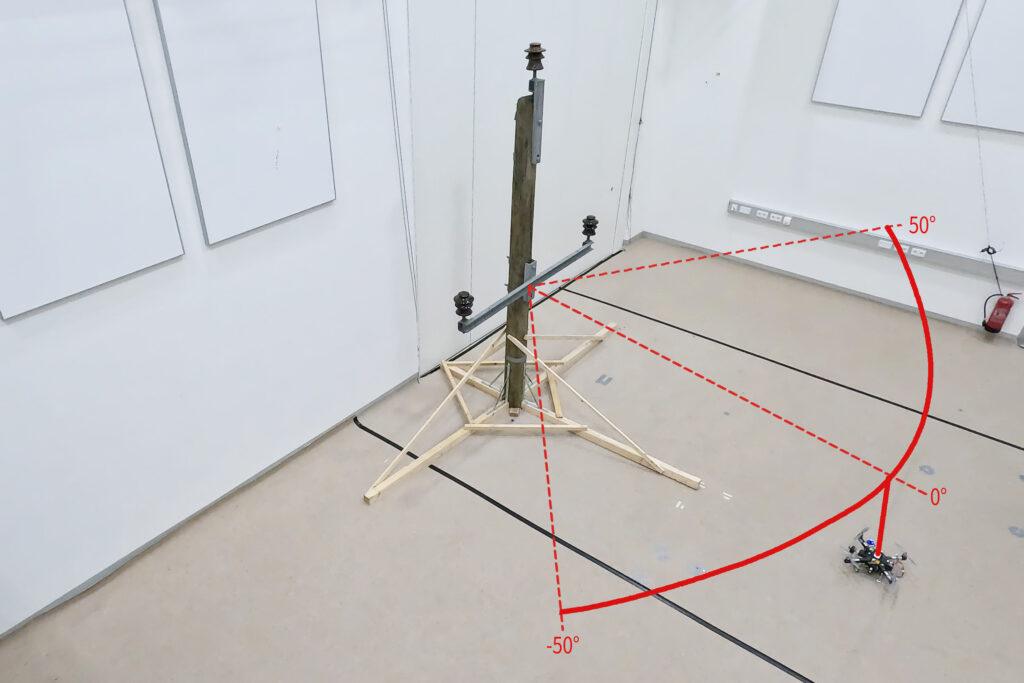
Precise, autonomous alignment through sensor fusion
The high-frequency control signals for the drone are generated by the IMU (Inertial Measurement Unit). Sensor fusion with camera data, LIDAR or GNSS (Global Navigation Satellite System) enables real-time navigation and stabilisation of the drone – for example for position corrections or precise alignment with inspection objects. For the Klagenfurt drone, the IMU of the PX4 is used as a dynamic model in an EKF (Extended Kalman Filter). The EKF estimates where the drone should be now based on the last known position, speed and attitude. New data (e.g. from IMU, GNSS or camera) is then recorded at up to 200 Hz and incorprated into the state estimation process.
The camera captures raw images at 50 fps and an image size of 1280 x 960px. „This is the maximum frame rate that we can achieve with our AI model on the drone’s onboard computer,“ explains Thomas Jantos. When the camera is started, an automatic white balance and gain adjustment are carried out once, while the automatic exposure control remains switched off. The EKF compares the prediction and measurement and corrects the estimate accordingly. This ensures that the drone remains stable and can maintain its position autonomously with high precision.
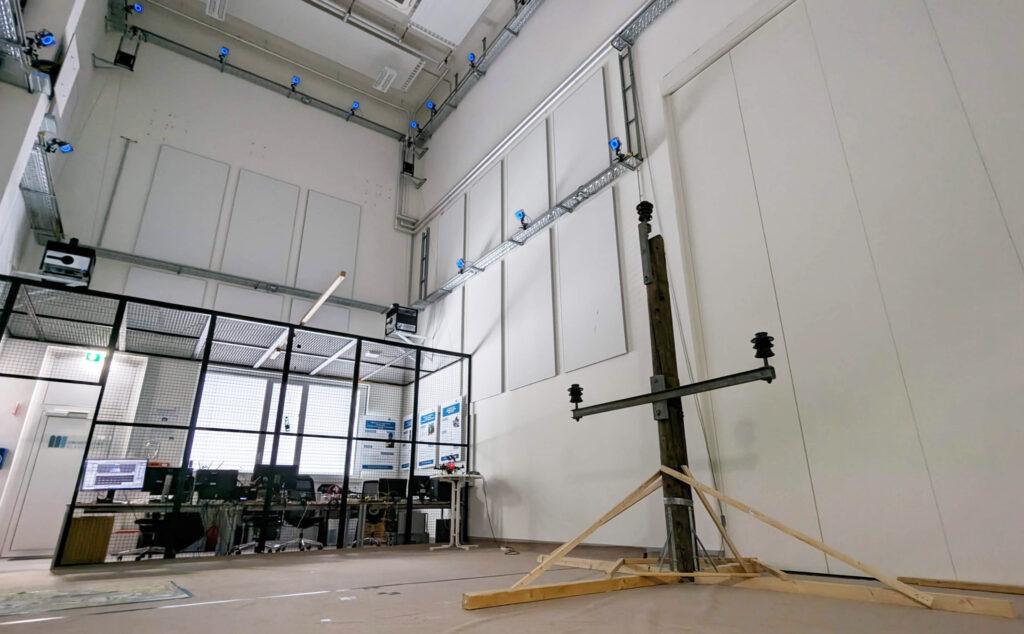
Outlook
„With regard to research in the field of mobile robots, industrial cameras are necessary for a variety of applications and algorithms. It is important that these cameras are robust, compact, lightweight, fast and have a high resolution. On-device pre-processing (e.g. binning) is also very important, as it saves valuable computing time and resources on the mobile robot,“ emphasises Thomas Jantos.
With corresponding features, IDS cameras are helping to set a new standard in the autonomous inspection of critical infrastructures in this promising research approach, which significantly increases safety, efficiency and data quality.
The Control of Networked Systems (CNS) research group is part of the Institute for Intelligent System Technologies. It is involved in teaching in the English-language Bachelor’s and Master’s programs „Robotics and AI“ and „Information and Communications Engineering (ICE)“ at the University of Klagenfurt. The group’s research focuses on control engineering, state estimation, path and motion planning, modeling of dynamic systems, numerical simulations and the automation of mobile robots in a swarm: More information
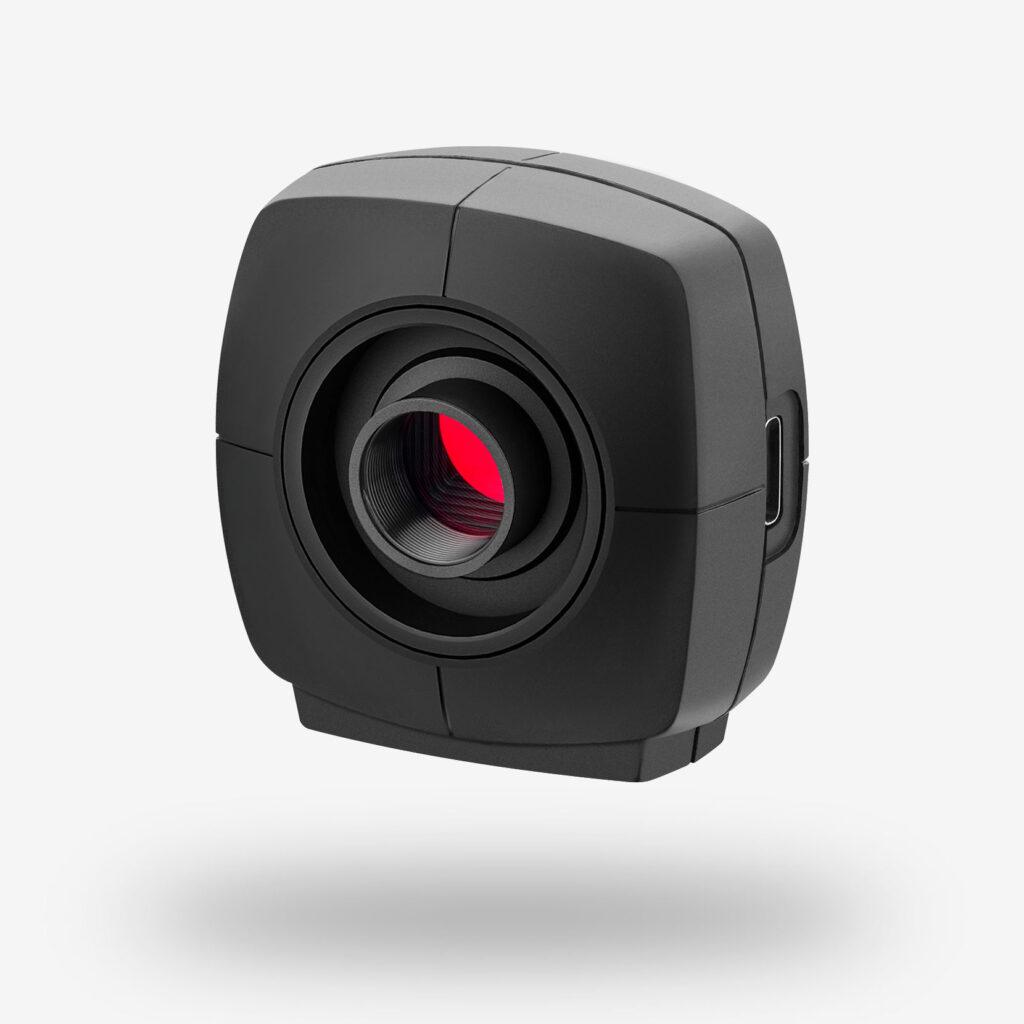
Model used:USB3 Vision Industriekamera U3-3276LE Rev.1.2
Camera family: uEye LE
Image rights: Alpen-Adria-Universität (aau) Klagenfurt
© 2025 IDS Imaging Development Systems GmbH
Maker-Bewegung prägt die digitale Transformation
Hannover, 25. März 2025 ‒ Was in einer kalifornischen Garage begann, prägt heute die globale Innovationslandschaft: 2025 feiert das US-Make-Magazin sein 20-jähriges Bestehen und gleichzeitig die Maker-Bewegung als bedeutenden Treiber der digitalen Transformation. Die deutsche Maker Faire in Hannover ist nach San Francisco und Rom zur drittgrößten weltweit gewachsen und lockte in über 10 Jahren mehr als 140.000 Besucher an.
„Die Maker-Bewegung existierte schon immer, aber erst das Make Magazin gab ihr 2005 einen Namen und eine Identität”, erklärt Dale Dougherty, Gründer des US-Make-Magazins. Was als Zeitschrift begann, entwickelte sich schnell zu einem globalen Phänomen: Seit der ersten Maker Faire 2006 fanden weltweit 1.497 Events mit über 131.000 ausstellenden Makern und mehr als 7,6 Millionen Teilnehmern statt.
Die deutsche Erfolgsgeschichte begann 2011 mit „c’t Hardware Hacks”, dem Vorläufer des heutigen Make-Magazins . „Die Maker-Bewegung hat eine neue Form der Produktionsorganisation etabliert, die auf Internet und Peer-Netzwerken basiert. Durch den offenen Zugang zu digitalen Fertigungstechnologien ist eine moderne, demokratische Innovationskultur entstanden”, erklärt Daniel Bachfeld, Chefredakteur des deutschen Make-Magazins. „Jeder kann heute mit 3D-Druckern, Laser-Cuttern und Open-Source-Elektronik eigene Produkte entwickeln und herstellen.“
In FabLabs und Makerspaces entstehen neue Produktionsinfrastrukturen, die intelligente Robotik mit kollaborativen Arbeitsweisen verbinden. Der „Do-It-With-Others”-Ansatz führt zu einer dezentralen, lokalen Fertigung. Dabei entwickeln sich flexible Wertschöpfungsketten, die durch moderne Software gesteuert werden.

Die Bewegung prägt auch die Bildungslandschaft: „Making verbindet digitale und handwerkliche Fähigkeiten und fördert kreative Problemlösung”, sagt Bachfeld. Immer mehr Schulen und Universitäten integrieren Maker-Projekte in ihre Lehrpläne oder eröffnen genau wie viele Bibliotheken eigene Makerspaces.
Auch im Make-Magazin wird der Bildungsansatz forciert: In Kooperation mit dem Schweizer Hersteller Oxon entstand beispielsweise das Make Innovators Kit mit Playbook. Gemeinsam mit dem Umweltcampus der Hochschule Trier wurde das Makey:Lab entwickelt, das Schülern ab 14 Jahren den Einstieg in digitale Umweltforschung und Programmierung ermöglicht.
Die Maker Faire Hannover hat sich seit 2013 als inspirierender Ideenpool etabliert. „Der Mix aus Wissenschaftsmesse und buntem DIY-Festival bringt Menschen jeden Alters und Hintergrunds zusammen, um die vielseitigen Kreationen zu präsentieren oder zu bestaunen – von selbstgebauten Robotern bis zu kinetischen Skulpturen”, unterstreicht Daniel Rohlfing, Leiter Events & Sales Maker Faire Deutschland. “Auch die MINT-Bildung kommt nicht zu kurz. Kinder und Jugendliche werden auf der Maker Faire für die digitale Welt, IT, KI und Technik nachhaltig begeistert”.

Seit vielen Jahren übernimmt das Bundesbildungsministerium die Schirmherrschaft für die Maker Faire, für Rohlfing ein großes Zeichen der Wertschätzung.
Die nächste Maker Faire Hannover findet am 23. und 24. August 2025 im Hannover Congress Centrum statt, der Call for Makers ist noch bis Ende Mai geöffnet, auch Unternehmen können sich für eine Teilnahme anmelden.

Im DACH-Raum wächst die Bewegung ebenfalls: Die Maker Faire Ruhr lädt für den 29. und 30. März in die DASA Arbeitswelt Ausstellung nach Dortmund ein. In der Schweiz öffnet die Maker Faire Solothurn am 28. und 29. Juni 2025 ihre Tore in der Enter Technikwelt.
Kreativität in Bewegung: Der modulare Roboter Otto von HP Robots
Der HP Robots Otto ist ein vielseitiger, modularer Roboter, der speziell für Bildungszwecke entwickelt wurde. Er bietet Schülern und Lehrern eine spannende Möglichkeit, in die Welt der Robotik, 3D-Druck, Elektronik und Programmierung einzutauchen. Der Roboter wurde von HP als Teil ihrer Robotik-Initiative entwickelt und ist besonders für den Einsatz im MINT-Unterricht (Mathematik, Informatik, Naturwissenschaften und Technik) geeignet.
Hauptmerkmale von Otto:
- Modularer Aufbau: Otto ist ein modularer Roboter, der es Schülern ermöglicht, ihn zu bauen, zu programmieren und durch Erweiterungen individuell anzupassen. Dies fördert das Verständnis für Technik und Kreativität. Die modulare Struktur erlaubt es, verschiedene Komponenten wie Motoren, Sensoren und LEDs hinzuzufügen oder zu ersetzen, was die Lernkurve für Schüler erweitert.
- Programmierbarkeit: Der Roboter kann mit verschiedenen Programmiersprachen programmiert werden, darunter blockbasierte Programmierung für Anfänger sowie Python und C++ für Fortgeschrittene. Diese Vielfalt ermöglicht es Schülern, ihre Programmierfähigkeiten kontinuierlich zu verbessern und sich an die Komplexität der Aufgaben anzupassen.
- Sensoren und Funktionen: Ausgestattet mit Ultraschallsensoren zur Hinderniserkennung, Linienverfolgungssensoren und RGB-LEDs bietet Otto zahlreiche interaktive Möglichkeiten. Diese Funktionen ermöglichen es Schülern, komplexe Aufgaben wie das Navigieren durch Parcours oder das Verfolgen von Linien zu programmieren. Die Sensoren helfen dabei, die Umgebung zu erkennen und entsprechend zu reagieren.
- 3D-Druck und Anpassbarkeit: Schüler können Ottos äußere Teile selbst entwerfen und mit einem 3D-Drucker herstellen. Dies ermöglicht eine weitere Personalisierung und Anpassung des Roboters. Diese Kreativfreiheit fördert nicht nur technisches Verständnis, sondern auch künstlerische Fähigkeiten. Eigene Teile können entworfen und Sensoren an gewünschten Stellen angebracht werden.
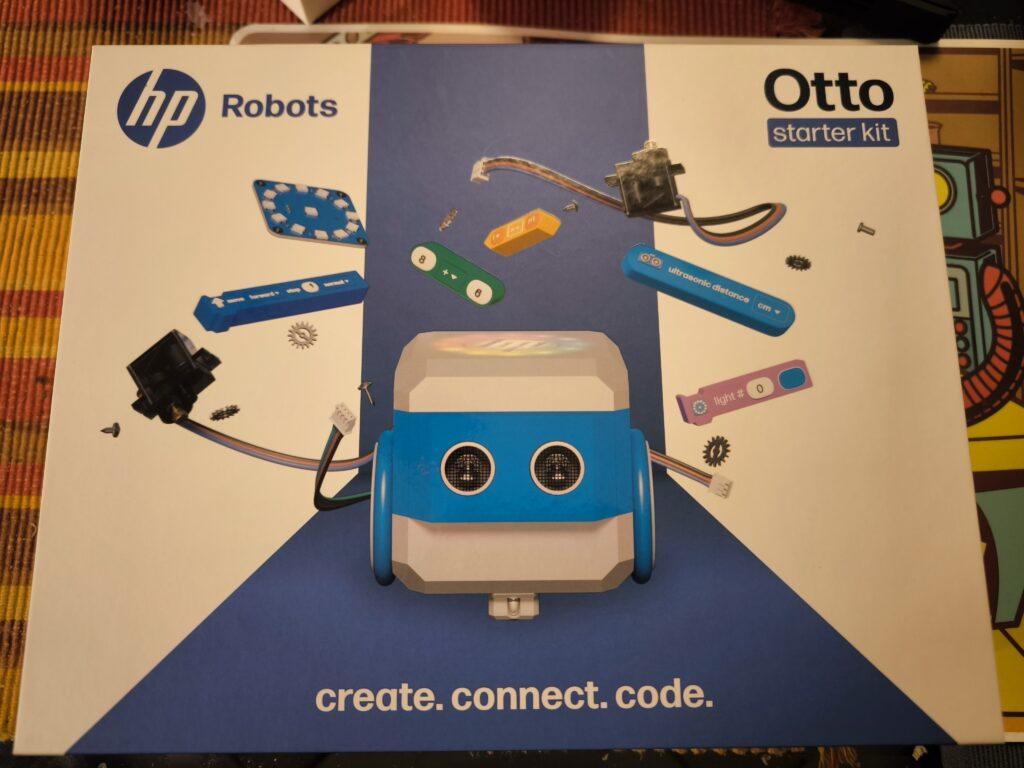
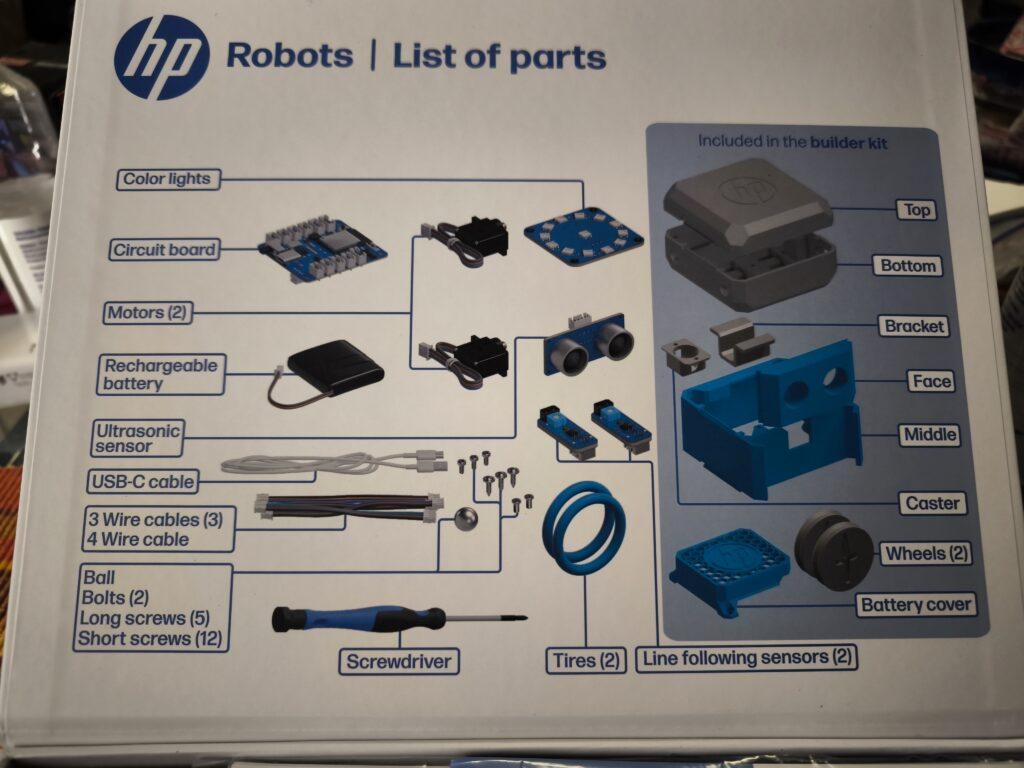
Bildungsansatz:
Otto ist ideal für den Einsatz in Schulen gedacht und richtet sich an Schüler ab 8 Jahren. Jüngere Schüler können unter Aufsicht arbeiten, während ältere Schüler ab 14 Jahren den Roboter auch eigenständig nutzen und erweitern können. Das Kit enthält alle notwendigen Komponenten, um einen funktionierenden Roboter zu bauen, einschließlich Motoren, Sensoren und einer wiederaufladbaren Batterie.
Programmierumgebungen:
Die Programmierung von Otto erfolgt über eine webbasierte Plattform, die auf allen Betriebssystemen läuft. Diese Plattform bietet verschiedene Modi:
- Blockbasierte Programmierung: Ähnlich wie Scratch Jr., ideal für Anfänger. Diese visuelle Programmierung erleichtert den Einstieg in die Welt der Programmierung und hilft Schülern, grundlegende Konzepte wie Schleifen und Bedingungen zu verstehen.
- Python: Für fortgeschrittene Benutzer steht ein Python-Editor zur Verfügung. Python ist eine beliebte Sprache, die sich gut für den Unterricht eignet, da sie einfach zu lesen und zu schreiben ist. Schüler können mit Python komplexere Algorithmen entwickeln und ihre Fähigkeiten im Bereich der Programmierung erweitern.
- C++: Kompatibel mit der Arduino IDE für Nutzer, die tiefere Programmierkenntnisse haben. C++ bietet eine hohe Flexibilität und ermöglicht es Schülern, direkt auf die Hardware zuzugreifen, was eigene fortgeschrittene Projekte ermöglicht.
Expansion/Erweiterungs Kits:
Zusätzlich zum Starter Kit gibt es mehrere Erweiterungskits. Alle Erweiterungskits setzen das Starter-Kit voraus, da sie auf dessen Basis aufgebaut werden.
Emote Expansion Kit:
- Es enthält Komponenten wie ein LED-Matrix-Display, OLED Display und einen MP3-Player, die es dem Roboter ermöglichen, visuelle und akustische Reaktionen darzustellen.
- Dieses Kit eignet sich besonders für kreative Projekte, bei denen Otto als interaktiver Begleiter fungieren soll.
- Das Emote-Kit ermöglicht es Otto, Emotionen zu zeigen, menschliche Interaktionen zu spiegeln und verschiedene Persönlichkeiten zu entwickeln.
Sense Expansion Kit:
- Mit dem Sense-Kit kann Otto seine Umgebung durch verschiedene Sensoren wahrnehmen.
- Enthalten sind Sensoren für Temperatur, Luftfeuchtigkeit, Licht und Geräusche sowie ein Neigungssensor. Diese ermöglichen vielfältige Interaktionen mit der Umwelt.
- Das Kit ist ideal für Projekte, die sich auf Umwelterkennung und Datenanalyse konzentrieren.
Interact Expansion Kit:
- Das Interact-Kit erweitert Ottos Fähigkeit zur taktilen Interaktion durch Module wie Drucktasten, Drehknöpfe und Beschleunigungsmesser.
- Es ermöglicht präzise Eingaben und Reaktionen sowie Messung der Beschleunigung.
- Dieses Kit eignet sich hervorragend für spielerische Aktivitäten und interaktive Spiele.
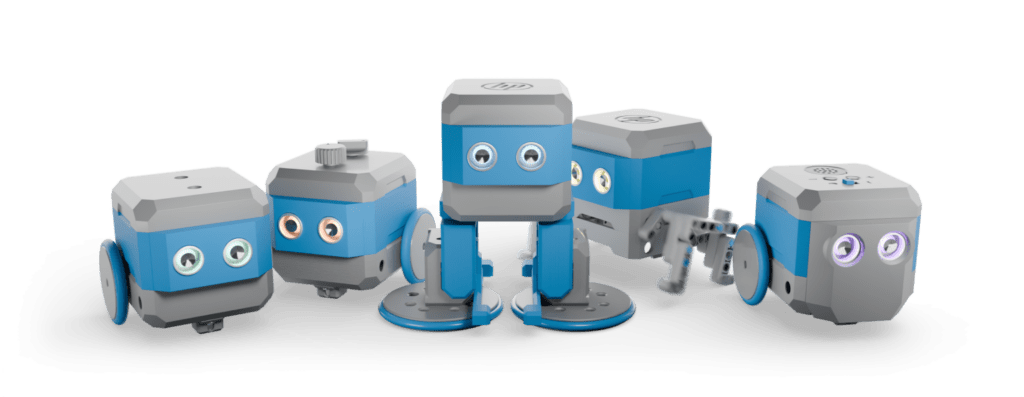
Invent Expansion Kit:
- Das Invent-Kit ist speziell darauf ausgelegt, die Kreativität der Benutzer zu fördern. Es erlaubt die individuelle Anpassung von Ottos Funktionalitäten und Design durch 3D-Druck und zusätzliche Module sowie kompatible Klemmbausteine.
- Benutzer können neue Zubehörteile entwerfen und drucken, um den Roboter einzigartig zu machen.
- Statte Otto mit Beinen aus und bring ihm das Laufen bei oder mache ihn mit Ketten fit für den Outdoor Einsatz im Gelände.
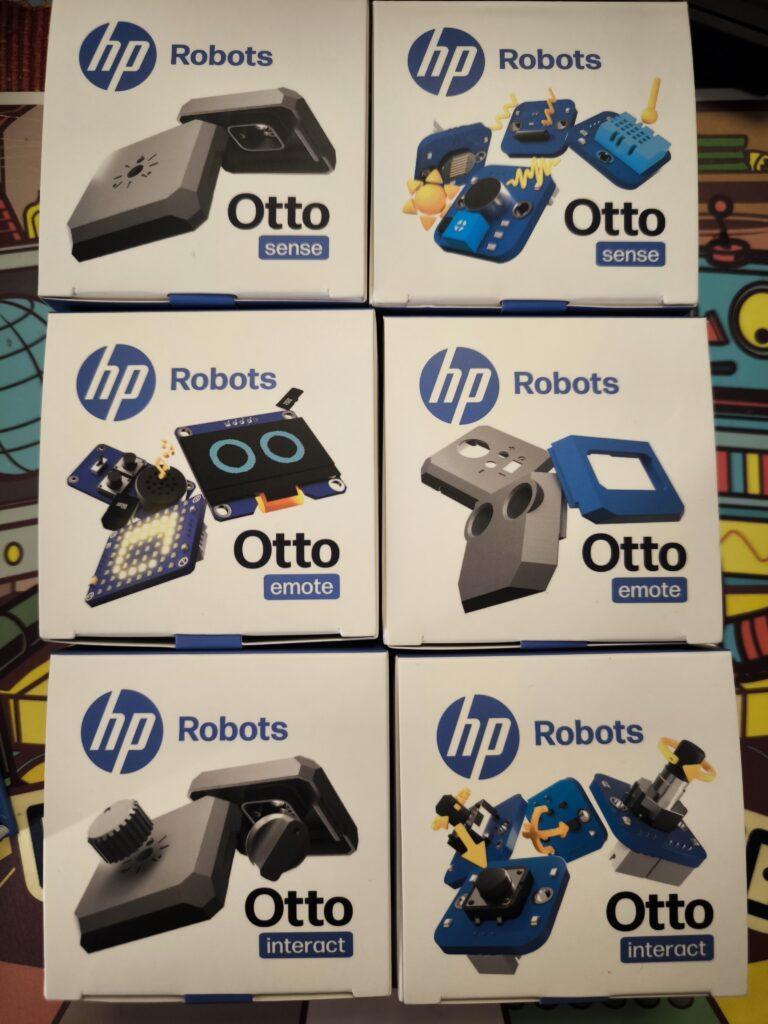
Einsatz im Unterricht:
Otto wird mit umfangreichen Ressourcen geliefert, die von Lehrern entwickelt wurden. Diese Materialien unterstützen Lehrer dabei, einen effektiven MINT-Unterricht zu gestalten, ohne dass Vorkenntnisse erforderlich sind. Der Roboter kann sowohl im Klassenraum als auch zu Hause eingesetzt werden. Die didaktischen Materialien umfassen:
- Lehrpläne: Strukturierte Unterrichtspläne, die den Lehrern helfen, den Unterricht zu planen und durchzuführen.
- Projektideen und Arbeitsblätter: Eine Vielzahl von Projekten, die Schüler dazu anregen, kreativ zu denken und ihre Fähigkeiten zu erweitern.
- Tutorials und Videos: Zusätzliche Lernmaterialien, die Schülern helfen, komplexe Konzepte besser zu verstehen.
Fazit:
Der HP Robots Otto ist ein hervorragendes Werkzeug zur Förderung von technischem Verständnis und Kreativität bei Schülern. Durch seine modulare Bauweise und die vielfältigen Programmiermöglichkeiten bietet er eine praxisorientierte Lernerfahrung im Bereich der Robotik und Elektronik. Otto ist ideal für den Einsatz in Schulen und bietet Lehrern eine umfassende Plattform, um Schüler auf eine spannende Reise in die Welt der Technologie zu begleiten. Besonders Ottos Vielseitigkeit durch die 3D-gedruckten Teile und Erweiterungspakete bieten die Möglichkeit, den persönlichen Lernroboter zu bauen.
Geek Club and CircuitMess in Partnership with Warner Bros. Discovery Global Consumer Product Launch Rick and Morty™ Butter Bot
After a string of successful Kickstarter campaigns, Geek Club and CircuitMess have teamed up once again to launch an exciting new project: an AI-powered desk robot designed especially for Rick and Morty fans.
Zagreb, Croatia – November 2024 – Geek Club and CircuitMess are thrilled to announce the official launch of their Kickstarter campaign for the Butter Bot, a revolutionary AI-powered robot inspired by the one made famous in the popular Adult Swim series, Rick and Morty, and first seen in season 1 episode 9. This innovative product is officially licensed by Warner Bros. Discovery Global Consumer Products (WBDGCP), bringing the iconic Butter Bot to life in a way fans have never seen before.
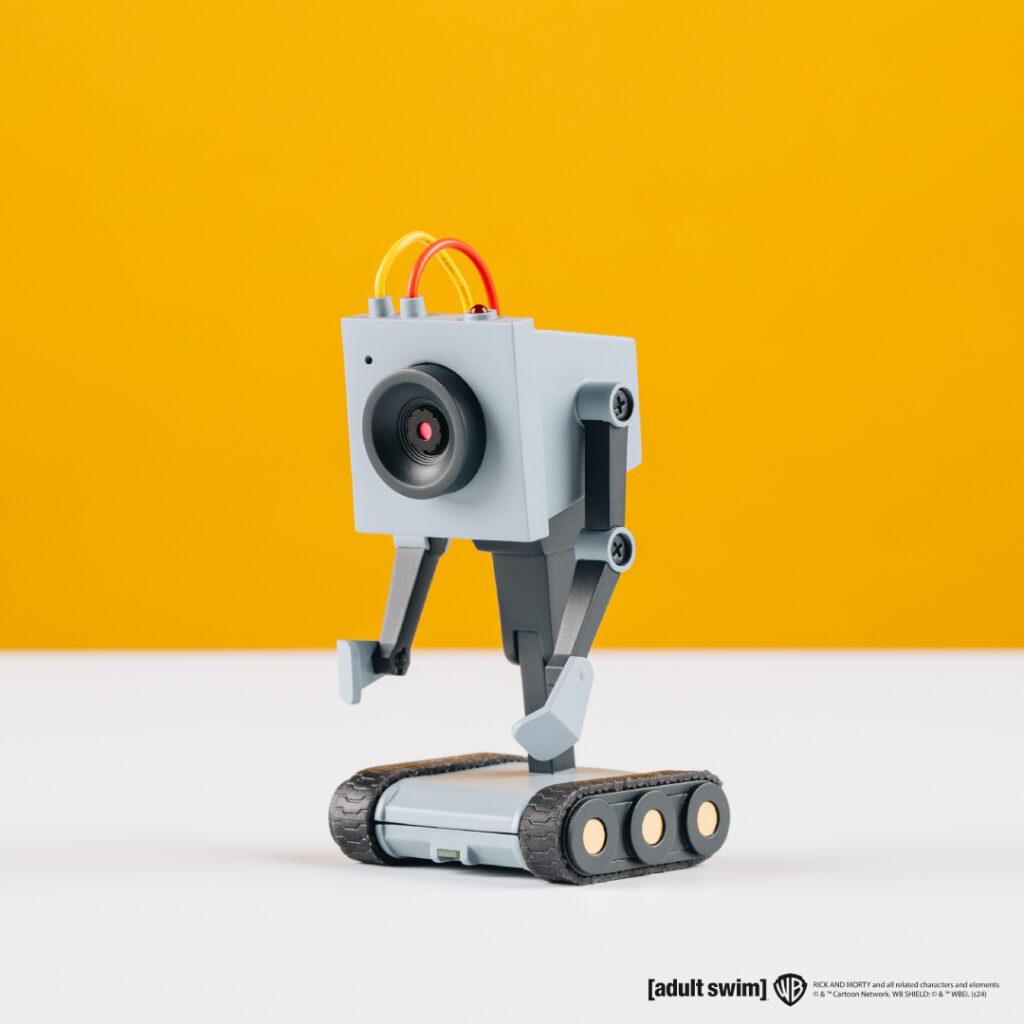
From Screen to Reality: A Partnership That Is Bringing Butter Bot to Life
A shared love of Rick and Morty show between CircuitMess and Geek Club teams led to this project. Both companies saw an opportunity to bring a beloved character to life in a way that was both true to the show and technologically innovative. They chose the Butter Bot because of its iconic status and potential for interactive, educational, and entertaining applications. By turning a simple butter-passing robot into a multifunctional AI companion, they aimed to create a product that would resonate with fans and tech enthusiasts alike, merging humor and functionality seamlessly.
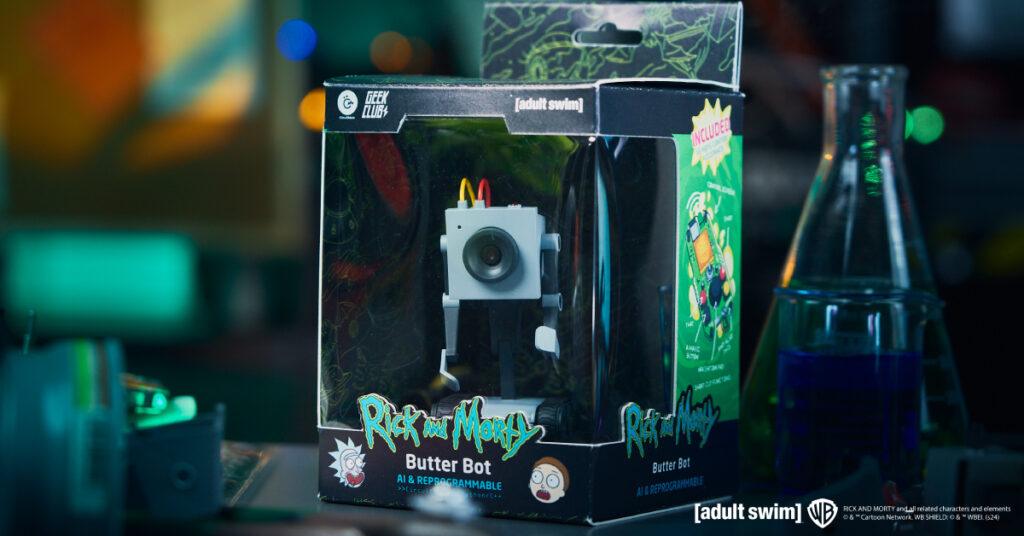
From Mars to Multiverse: The Next Chapter for CircuitMess and Geek Club
The collaboration was a logical union of the two companies after the massive success of the previous Kickstarter – NASA Perseverance AI-powered Mars Rover. Both companies create educational STEM DIY kits for kids and adults in order to make learning STEM skills easy and fun. While CircuitMess is focused primarily on toys, Geek Club’s products are always robot and space-themed.
„Partnering with WBDGCP on this project has been an exciting next step in our collaboration with Circtuit Mess, says Nico, co-founder of Geek Club, sharing his enthusiasm: “The Butter Bot is a testament to what happens when creativity, technology, and fandom collide. We’re excited to see the support and engagement from the community as we launch our Kickstarter campaign.“
Geek Club is an American company that specializes in designing and producing DIY robotics kits that educate their users on soldering and electronics. They focus primarily on space exploration and robotics, all to make learning engineering skills easy and fun for their young and adult audience.
Beyond Butter: Introducing the AI-Powered Butter Bot
The Butter Bot is not just a simple robot with the sole purpose of passing the butter, as originally in the show. It comes with a unique remote controller that allows for precise maneuvering of its movement while also providing a live feed from the bot’s camera. The interactive robot has advanced AI capabilities, making it a versatile companion in any setting.

„Bringing the Butter Bot from Rick and Morty into the real world has been an incredible journey,” says Albert Gajšak, CEO of CircuitMess, expressing his excitement about the launch: “We’ve poured our hearts into creating a product that not only honors the original character but also adds a whole new level of interactivity and functionality. We can’t wait to see how fans will use and enjoy it.“
To this day, CircuitMess has developed numerous educational products that encourage kids and adults to create rather than just consume. They successfully delivered 7 Kickstarter campaigns and made thousands of geeks worldwide extremely happy. CircuitMess‘ kits are a unique blend of resources for learning about hardware and software in a fun and exciting way.
The Butter Bot Kickstarter campaign offers backers exclusive early-bird pricing and special rewards.
For more information and to back the project, visit the Butter Bot Kickstarter page here (https://www.kickstarter.com/projects/albertgajsak/rick-and-mortytm-butter-bot-an-ai-powered-desk-robot), or check out the Geek Club and CircuitMess websites to see all their other kits.
About Geek Club
Geek Club is a crew of designers and engineers led by co-founders Nicolas Deladerrière and Nikita Potrashilin. Their mission is to build electronic construction kits for curious minds in over 70 countries worldwide. They are most often inspired by NASA and other Space Agencies of the world and hope to push their fans’ minds further, strengthen their skills, and advance their knowledge of electronics and Space.
Their vision is to create a world of inventors for the next generation of technology with their space-themed STEM kits. Find out more at www.geekclub.com.
Nicolas Deladerrière, co-founder of Geek Club
Mail: [email protected]
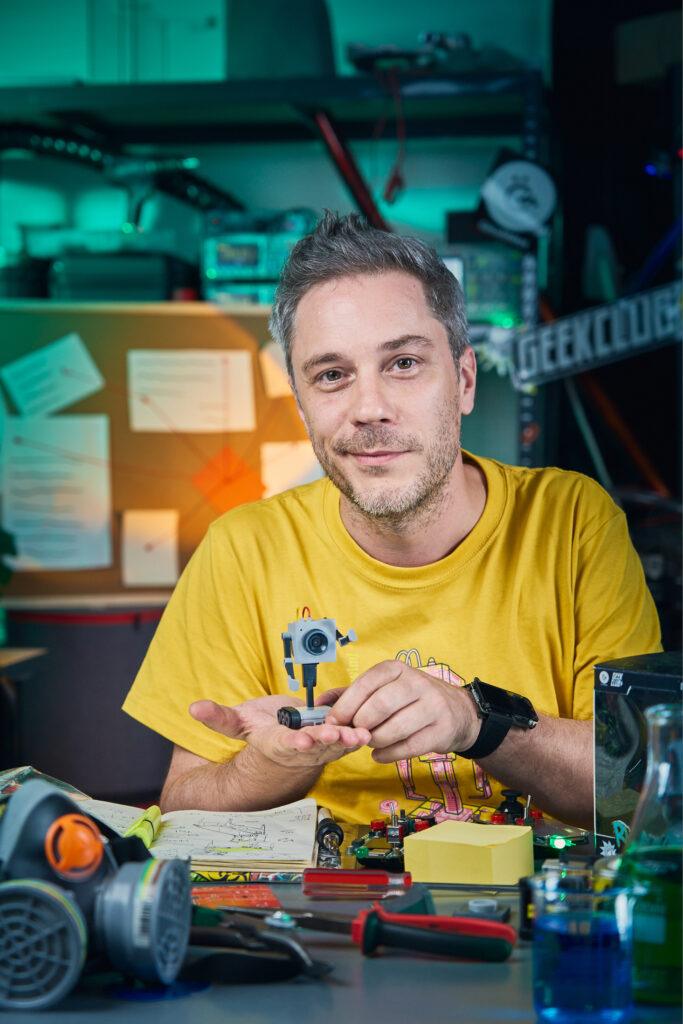
About CircuitMess
CircuitMess is a technology startup founded in 2017 by Albert Gajšak and Tomislav Car after a successful Kickstarter campaign for MAKERbuino.
CircuitMess employs young, ambitious people and has recently moved to a new office in Croatia’s capital, Zagreb, searching for talented individuals who will help them create unique electronic products and bring technology to the crowd in a fun and exciting way. Find out more at www.circuitmess.com.
Albert Gajšak, co-founder and CEO of CircuitMess
Mail: [email protected]
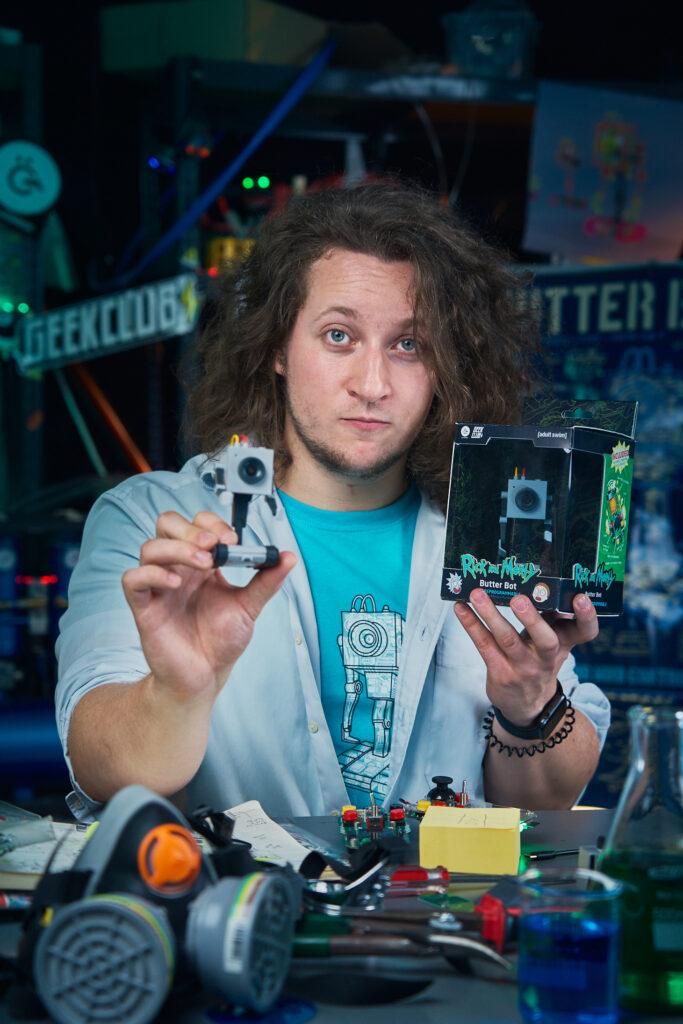
About Rick and Morty
Rick and Morty is the Emmy® award-winning half-hour animated hit comedy series on Adult Swim that follows a sociopathic genius scientist who drags his inherently timid grandson on insanely dangerous adventures across the universe. Rick Sanchez is living with his daughter Beth’s family and constantly bringing her, his son-in-law Jerry, granddaughter Summer, and grandson Morty into intergalactic escapades.
Rick and Morty stars Ian Cardoni, Harry Belden, Sarah Chalke, Chris Parnell, and Spencer Grammer.
About Warner Bros. Discovery Global Consumer Products
Warner Bros. Discovery Global Consumer Products (WBDGCP), part of Warner Bros. Discovery’s Revenue & Strategy division, extends the company’s powerful portfolio of entertainment brands and franchises into the lives of fans around the world. WBDGCP partners with best-in-class licensees globally on award-winning toy, fashion, home décor and publishing programs inspired by the biggest franchises from Warner Bros.’ film, television, animation, and games studios, HBO, Discovery, DC, Cartoon Network, HGTV, Eurosport, Adult Swim, and more. With innovative global licensing and merchandising programs, retail initiatives, and promotional partnerships, WBDGCP is one of the leading licensing and retail merchandising organizations in the world.
Geek Club und CircuitMess bringen dir deinen eigenen Rick & Morty Butter Bot
Nach einer Reihe erfolgreicher Kickstarter-Kampagnen haben sich Geek Club und CircuitMess erneut zusammengeschlossen, um ein aufregendes neues Projekt zu starten: ein AI-gesteuerter Tischroboter, der speziell für Fans von Rick und Morty entwickelt wurde.
Zagreb, Kroatien – November 2024 – Geek Club und CircuitMess freuen sich, den offiziellen Start ihrer Kickstarter-Kampagne für den Butter Bot bekannt zu geben, einen revolutionären Roboter, der von künstlicher Intelligenz gesteuert wird. Er ist inspiriert vom berühmten Roboter aus der beliebten Adult Swim-Serie Rick und Morty, der erstmals in Staffel 1, Folge 9 zu sehen war. Dieses innovative Produkt ist offiziell von Warner Bros. Discovery Global Consumer Products (WBDGCP) lizenziert, wodurch der kultige Butter Bot auf eine Weise zum Leben erweckt wird, wie es Fans noch nie zuvor gesehen haben.
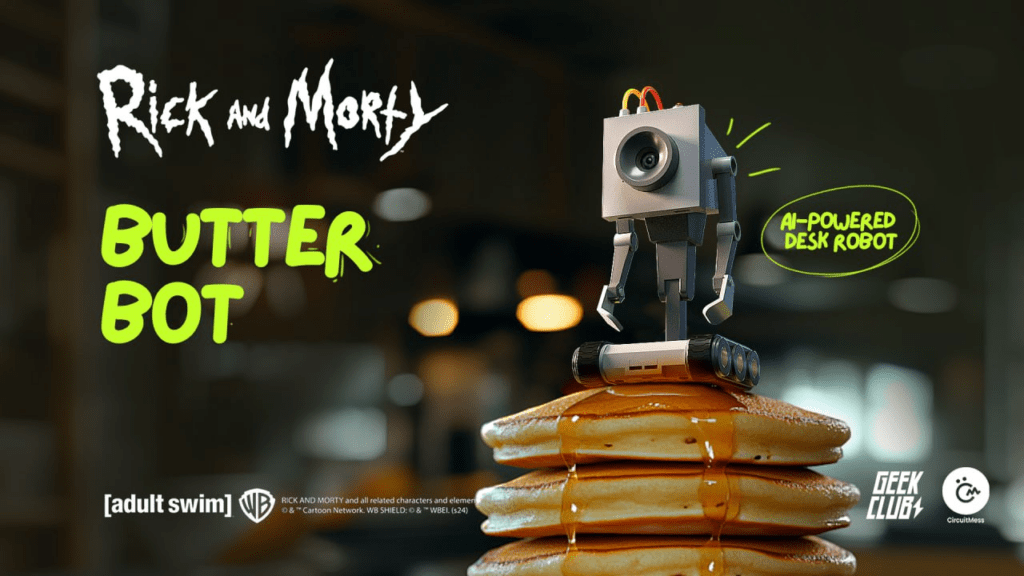
Vom Bildschirm in die Realität: Eine Partnerschaft, die den Butter Bot zum Leben erweckt
Die gemeinsame Liebe zur Serie Rick und Morty unter den Teams von CircuitMess und Geek Club führte zu diesem Projekt. Beide Unternehmen erkannten die Gelegenheit, einen geliebten Charakter auf eine Weise zum Leben zu erwecken, die sowohl der Serie treu bleibt als auch technologisch innovativ ist. Sie wählten den Butter Bot aufgrund seines ikonischen Status und seines Potenzials für interaktive, lehrreiche und unterhaltsame Anwendungen. Durch die Umwandlung eines einfachen Butter-überreichenden Roboters in einen multifunktionalen AI-Begleiter wollten sie ein Produkt schaffen, das sowohl bei Fans als auch bei Technikbegeisterten Anklang findet und nahtlos Humor und Funktionalität miteinander verbindet.
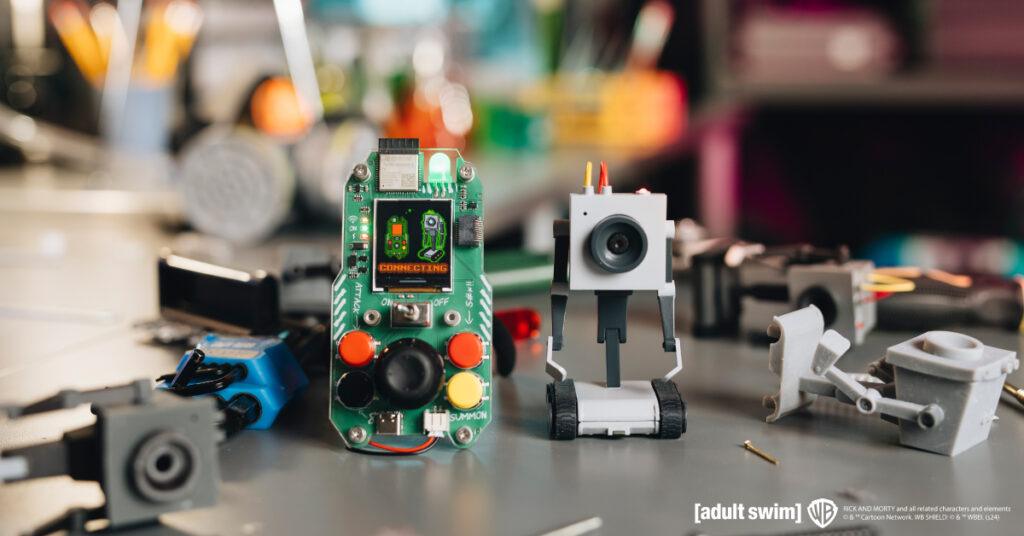
Von Mars bis Multiversum: Das nächste Kapitel für CircuitMess und Geek Club
Diese Zusammenarbeit war ein logischer Schritt für beide Unternehmen nach dem großen Erfolg des vorherigen Kickstarter-Projekts – dem NASA Perseverance AI-powered Mars Rover. Beide Unternehmen erstellen lehrreiche STEM-DIY-Kits für Kinder und Erwachsene, um das Erlernen von STEM-Fähigkeiten einfacher und unterhaltsamer zu gestalten. Während sich CircuitMess hauptsächlich auf Spielzeuge konzentriert, sind die Produkte von Geek Club immer robotik- und raumfahrtthemenbezogen.
„Die Zusammenarbeit mit WBDGCP bei diesem Projekt war ein spannender nächster Schritt in unserer Partnerschaft mit CircuitMess“, sagt Nico, Mitbegründer von Geek Club, und teilt seine Begeisterung: „Der Butter Bot ist ein Beweis dafür, was passiert, wenn Kreativität, Technologie und Fan-Leidenschaft aufeinandertreffen. Wir freuen uns darauf, die Unterstützung und das Engagement der Community zu erleben, während wir unsere Kickstarter-Kampagne starten.“
Geek Club ist ein amerikanisches Unternehmen, das sich auf das Design und die Herstellung von DIY-Roboterbausätzen spezialisiert hat, die ihre Nutzer in Löten und Elektronik schulen. Ihr Fokus liegt hauptsächlich auf Raumfahrt und Robotik, mit dem Ziel, das Erlernen von Ingenieursfähigkeiten für ihr junges und erwachsenes Publikum einfach und unterhaltsam zu machen.
Mehr als Butter: Vorstellung des AI-gesteuerten Butter Bot
Der Butter Bot ist nicht nur ein einfacher Roboter, dessen einzige Aufgabe es ist, wie in der Serie Butter zu überreichen. Er wird mit einer einzigartigen Fernbedienung geliefert, die präzises Manövrieren ermöglicht und gleichzeitig eine Live-Übertragung von der Kamera des Roboters bietet. Dieser interaktive Roboter verfügt über fortschrittliche AI-Funktionen und ist damit ein vielseitiger Begleiter in jeder Umgebung.
„Den Butter Bot aus Rick und Morty in die reale Welt zu bringen, war eine unglaubliche Reise“, sagt Albert Gajšak, CEO von CircuitMess, und drückt seine Begeisterung für den Launch aus: „Wir haben viel Herzblut in die Entwicklung eines Produkts gesteckt, das nicht nur dem Originalcharakter Ehre macht, sondern auch eine völlig neue Ebene der Interaktivität und Funktionalität hinzufügt. Wir können es kaum erwarten zu sehen, wie die Fans ihn nutzen und genießen werden.“
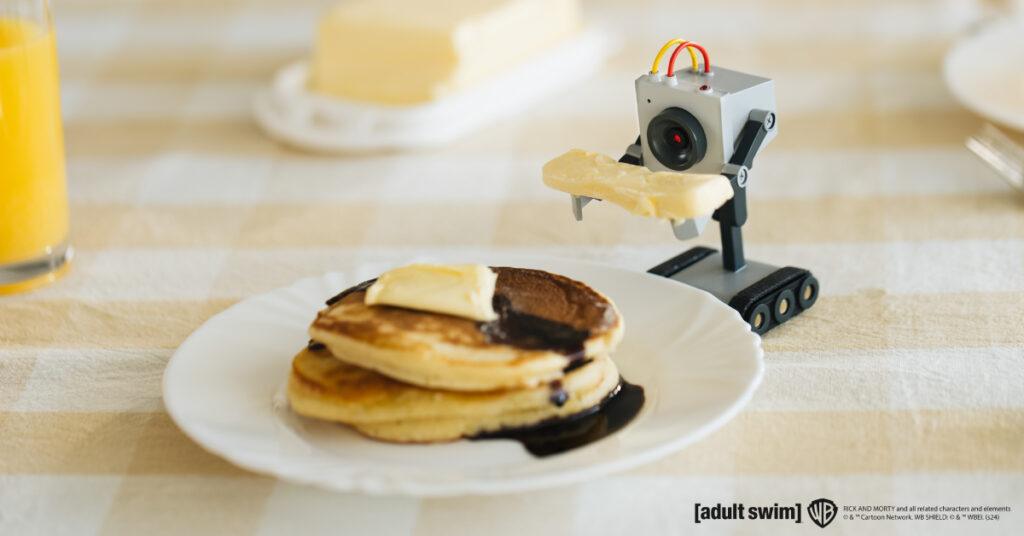
Bis heute hat CircuitMess zahlreiche lehrreiche Produkte entwickelt, die Kinder und Erwachsene dazu ermutigen, zu erschaffen, anstatt nur zu konsumieren. Sie haben erfolgreich 7 Kickstarter-Kampagnen abgeschlossen und tausende Geeks weltweit glücklich gemacht. Die Kits von CircuitMess sind eine einzigartige Kombination von Ressourcen, um auf unterhaltsame und aufregende Weise etwas über Hardware und Software zu lernen.
Die Kickstarter-Kampagne für den Butter Bot bietet Unterstützern exklusive Frühbucherpreise und spezielle Belohnungen.
Für weitere Informationen und zur Unterstützung des Projekts besuchen Sie die Kickstarter-Seite von Butter Bot hier (https://www.kickstarter.com/projects/albertgajsak/rick-and-mortytm-butter-bot-an-ai-powered-desk-robot) oder schauen Sie sich die Websites von Geek Club und CircuitMess an, um alle anderen Kits zu sehen.
Über Geek Club
Geek Club ist ein Team von Designern und Ingenieuren, das von den Mitbegründern Nicolas Deladerrière und Nikita Potrashilin geleitet wird. Ihre Mission ist es, elektronische Konstruktionskits für neugierige Köpfe in über 70 Ländern weltweit zu entwickeln. Ihre Inspiration kommt meist von der NASA und anderen Weltraumagenturen der Welt, und sie hoffen, den Geist ihrer Fans weiter zu fördern, ihre Fähigkeiten zu stärken und ihr Wissen über Elektronik und Weltraum zu erweitern.
Ihre Vision ist es, mit ihren weltraumthematischen STEM-Kits eine Welt von Erfindern für die nächste Technologiegeneration zu schaffen. Mehr erfahren Sie unter www.geekclub.com.
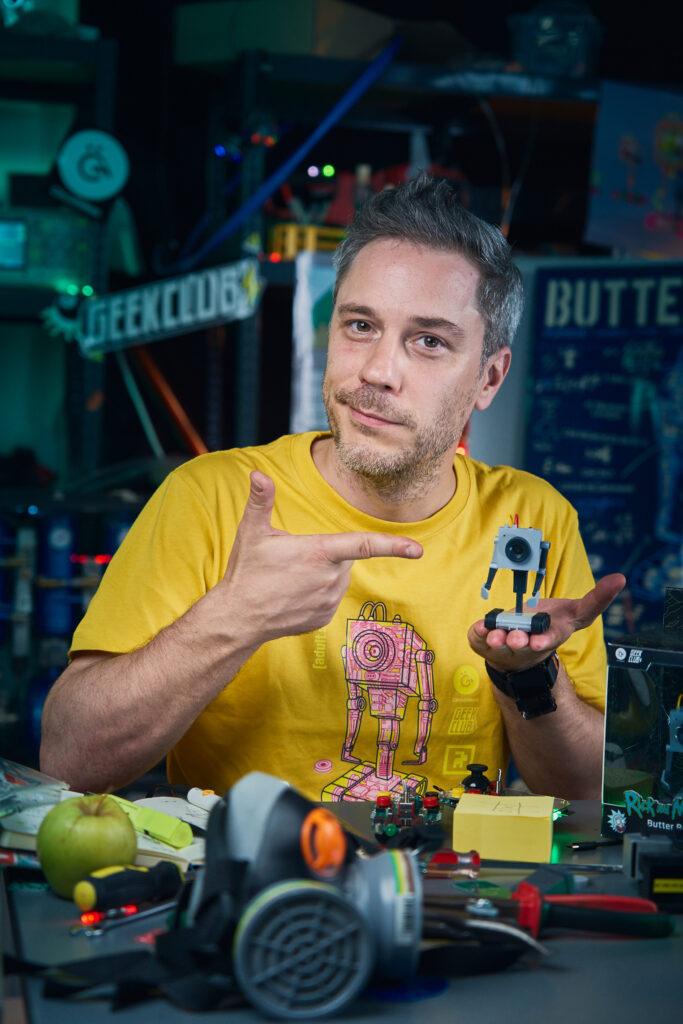
Nicolas Deladerrière, Mitbegründer von Geek Club
E-Mail: [email protected]
Über CircuitMess
CircuitMess ist ein Technologie-Startup, das 2017 von Albert Gajšak und Tomislav Car nach einer erfolgreichen Kickstarter-Kampagne für MAKERbuino gegründet wurde.
CircuitMess beschäftigt junge, ehrgeizige Menschen und ist kürzlich in ein neues Büro in der kroatischen Hauptstadt Zagreb umgezogen. Dort suchen sie nach talentierten Einzelpersonen, die ihnen helfen, einzigartige elektronische Produkte zu entwickeln und Technologie auf unterhaltsame und aufregende Weise für die breite Masse zugänglich zu machen. Mehr erfahren Sie unter www.circuitmess.com.

Albert Gajšak, Mitbegründer und CEO von CircuitMess
E-Mail: [email protected]
Über Rick and Morty
Rick und Morty ist eine Emmy®-preisgekrönte halbstündige animierte Hitkomödie des Senders Adult Swim, die einem soziopathischen genialen Wissenschaftler folgt, der seinen von Natur aus ängstlichen Enkel auf gefährliche Abenteuer im ganzen Universum mitnimmt. Rick Sanchez lebt bei der Familie seiner Tochter Beth und bringt ständig ihren Ehemann Jerry, ihre Enkelin Summer und ihren Enkel Morty in intergalaktische Eskapaden.
In den Hauptrollen spielen Ian Cardoni, Harry Belden, Sarah Chalke, Chris Parnell und Spencer Grammer.
Über Warner Bros. Discovery Global Consumer Products
Warner Bros. Discovery Global Consumer Products (WBDGCP), Teil der Revenue & Strategy-Abteilung von Warner Bros. Discovery, erweitert das mächtige Portfolio der Unterhaltungsmarken und -franchises des Unternehmens in das Leben der Fans auf der ganzen Welt. WBDGCP arbeitet weltweit mit erstklassigen Lizenznehmern an preisgekrönten Programmen für Spielzeug, Mode, Wohnkultur und Verlagswesen, die von den größten Franchises der Warner Bros.-Film-, Fernseh-, Animations- und Spiele-Studios, HBO, Discovery, DC, Cartoon Network, HGTV, Eurosport, Adult Swim und mehr inspiriert sind.
Mit innovativen globalen Lizenz- und Merchandising-Programmen, Einzelhandelsinitiativen und Werbepartnerschaften ist WBDGCP eine der führenden Organisationen für Lizenzierung und Einzelhandelsmerchandising weltweit.
IDS Showcases Groundbreaking 2D, 3D, and AI-Based Vision Systems at SPS 2024 in Nuremberg, Germany
Innovative Industrial Cameras for Robotics and Process Automation to Take Center Stage at Stand 6-36
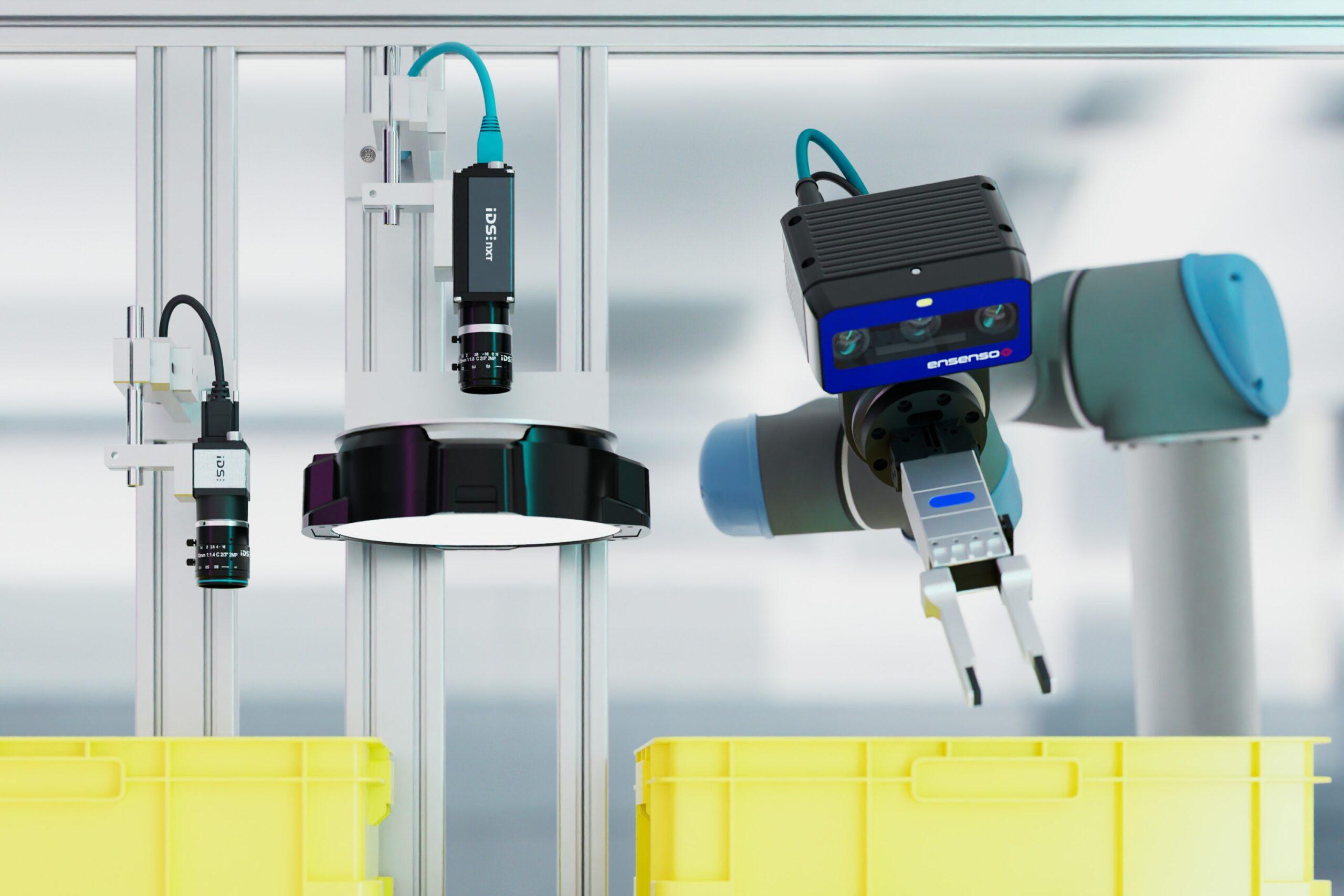
Detecting the smallest errors, increasing throughput rates, preventing wear – industrial cameras provide important information for automated processes. IDS will be demonstrating which technologies and products are particularly relevant at SPS / Smart Production Solutions in Nuremberg, Germany, from 12 to 14 November. If you want to experience how small cameras can achieve big things, stand 6-360 is the right place to visit.

Around 1,200 companies will be represented in a total of 16 exhibition halls at the trade fair for smart and digital automation. IDS will be taking part for the first time, focussing on industrial image processing for robotics, process automation and networked systems. Philipp Ohl, Head of Product Management at IDS, explains: „Automation and cameras? They go together like a lock and key. Depending on the task, very different qualities are required – such as particularly high-resolution images, remarkably fast cameras or models with integrated intelligence.“ Consequently, the products and demo systems that the company will be showcasing at SPS are highly diverse.
The highlights of IDS can be divided into three categories: 2D, 3D and AI-based image processing. The company will be presenting uEye Live, a newly developed product line. These industrial-grade monitoring cameras enable live streaming and are designed for the continuous monitoring and documentation of processes. IDS will also be introducing a new event-based sensor that is recommended for motion analyses or high-speed counting. It enables the efficient detection of rapid changes through continuous pixel-by-pixel detection instead of the usual sequential image-by-image analysis.
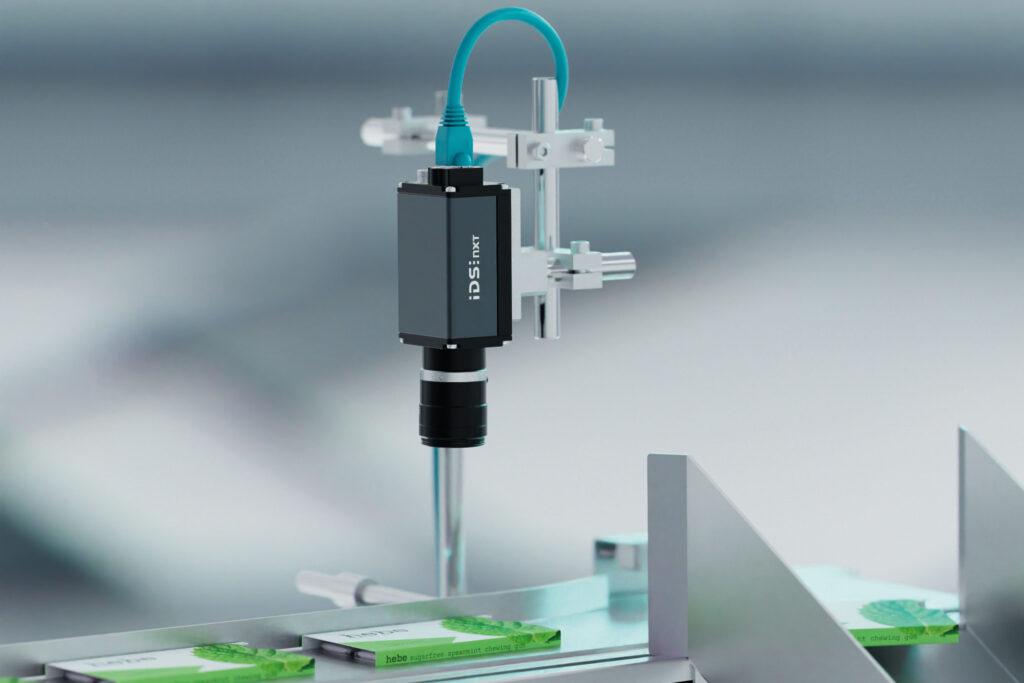
In the 3D cameras product segment, IDS will be demonstrating the advantages of the new stereo vision camera Ensenso B for precise close-range picking tasks as well as a prototype of the first time-of-flight camera developed entirely in-house. Anyone interested in robust character recognition will also find what they are looking for at the trade fair stand: Thanks to DENKnet OCR, texts and symbols on surfaces can be reliably identified and processed. IDS will be exhibiting at SPS, stand 6-360.
More information: https://en.ids-imaging.com/sps-2024.html
Argo – Your AI Smart Companion Robot
Guess what? There’s a new robot in town: Argo, the AI Smart Companion Robot for your home! „How is it possible that in 2024 we still don’t have personal robots in our homes?“
This very question sparked the creation of Argo. And who better to tackle this challenge than three innovators who have built driverless cars, drones, rockets, and space robotic arms? Their vision: to create the smart personal home robot we’ve been waiting for!
Argo excels in three main areas:
● INTELLIGENCE: ChatGPT-level conversational abilities, smart home integration (domotics) and autonomous navigation to move and follow you around your home.
● SECURITY: 24/7 video surveillance, autonomous patrolling to check every room, motion detection for intruders, and even gas leak monitoring.
● ENTERTAINMENT: From playing your favorite music to autonomously delivering drinks, Argo makes everyday life more enjoyable, with fun features like the morning alarm or the ed-tech games for your kids.
But that’s just the start. To explore all of Argo’s features, visit their website: argorobot.it.
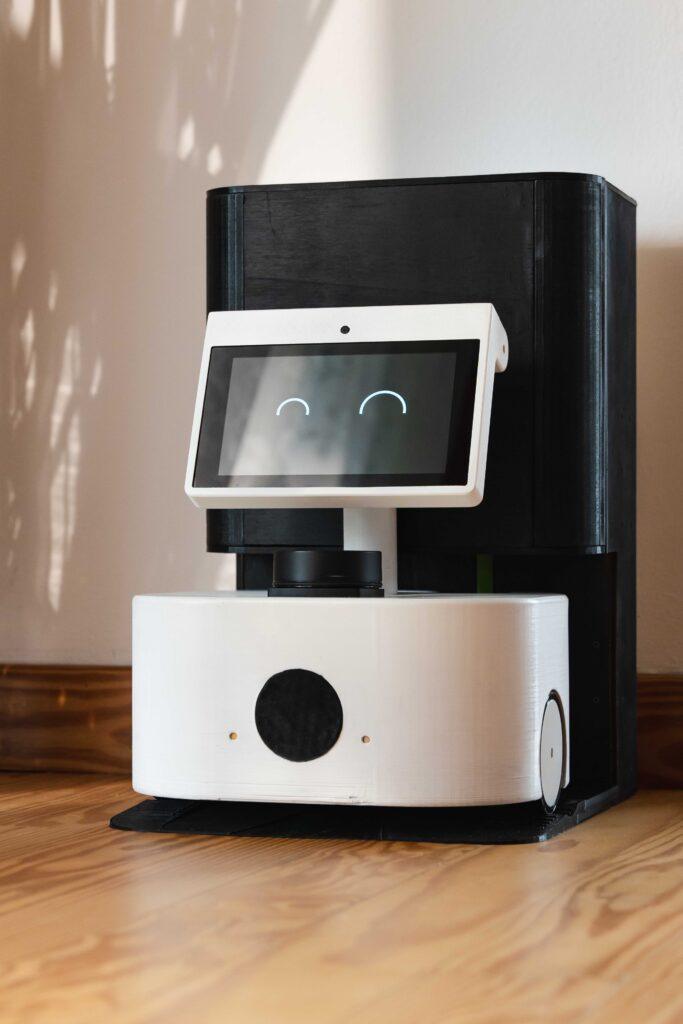
The intuition behind Argo is that today we still have basic vocal assistants, static boxes used just to set timers, play music. In some years, we will have humanoid robots doing laundry and cooking for us. Will we switch overnight from Alexa to fully humanoid robots? Probably not. Argo is that essential step in between, and it will keep evolving day by day.
So Argo isn’t just „Alexa on wheels.“ With its mobility, interactive animations and true conversational AI, Argo delivers an entirely different user experience: one that feels more alive and engaging than simply talking to a static device.
As the famous roboticist Tomotaka Takahashi once said: „Having people talk to a brick doesn’t work, which is why Siri hasn’t succeeded.“
So Argo is an interactive companion, your AI chatty buddy and your infinite source of knowledge!
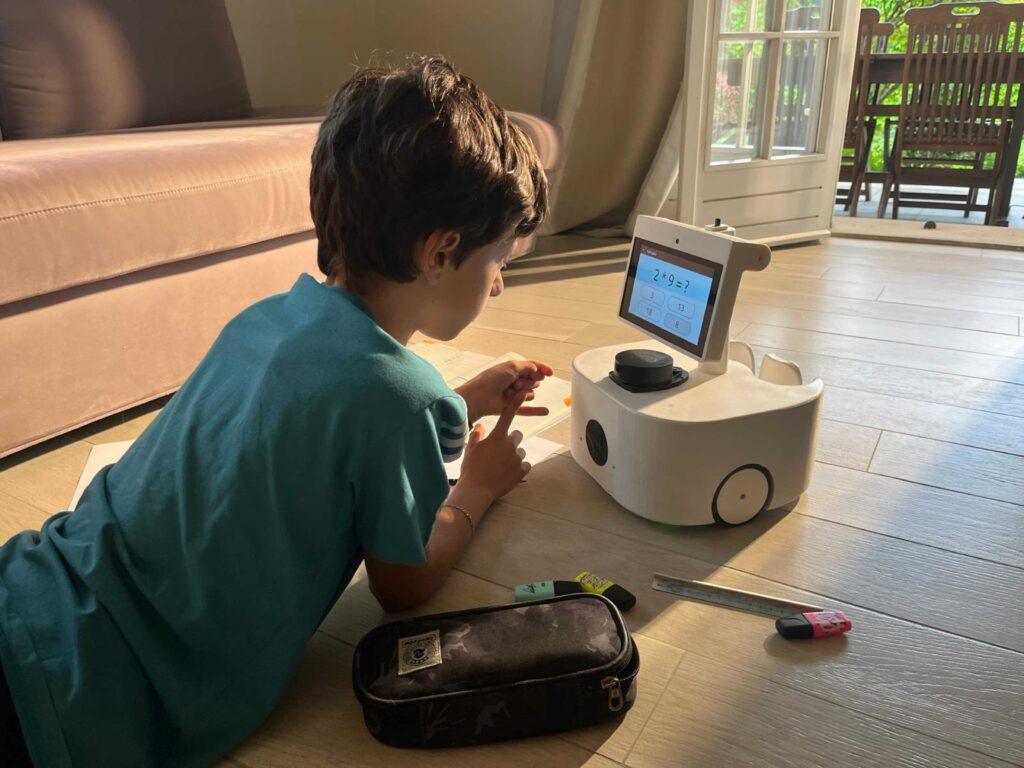
Sure, we’ve seen other unfortunate attempts in home robots before, like Kuri or Jibo, which were true pioneers. However, the technology back then wasn’t quite there. AI, LLMs and autonomous navigation systems were still in their infancy. Today, we have the tools to push the boundaries even further and at a fraction of the cost.
When you compare Argo to other robots on the market like Vector or Loona, while impressive, they tend to lean more toward toy-like design and functionality. And then there’s Amazon Astro, a high-tech marvel, but at $1,600 its price tag doesn’t align with the value it offers. Argo strikes the perfect balance: it’s more sophisticated, less of a toy and significantly more affordable, targeting a $499 price point.
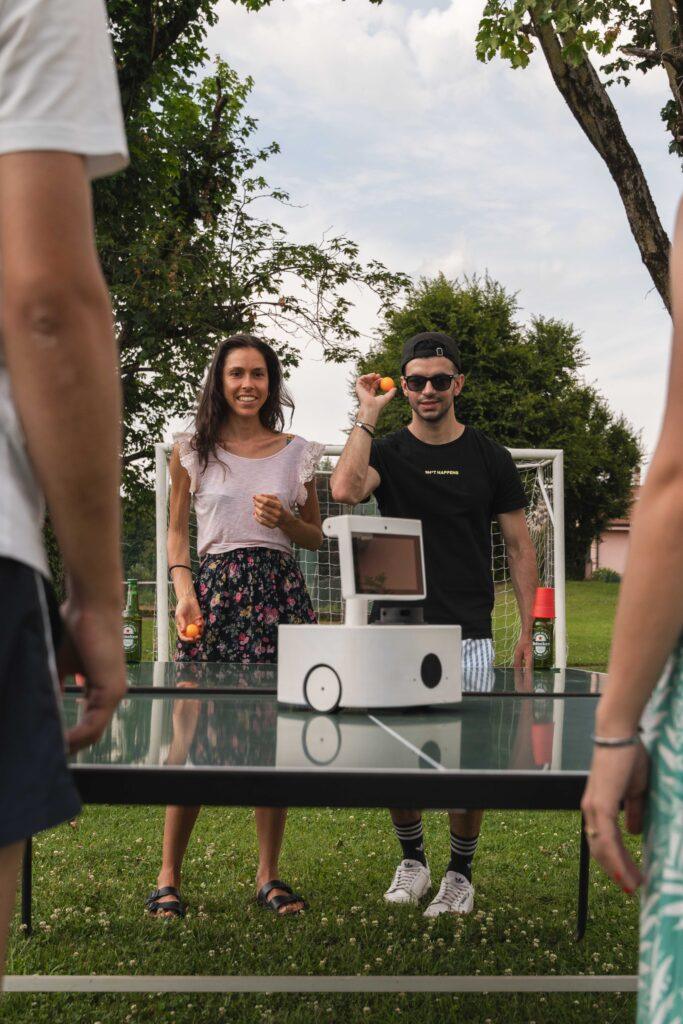
We’re seeing tech giants like Amazon and Apple (project J595) getting serious about this space, and it’s clear that smarter home robots are coming. Argo is here to be part of that revolution!
Do you want to share your ideas about home robots? Fill this quick survey to help Argo guys to craft the best home robot for you: https://forms.gle/MmNLc15wH5invino9
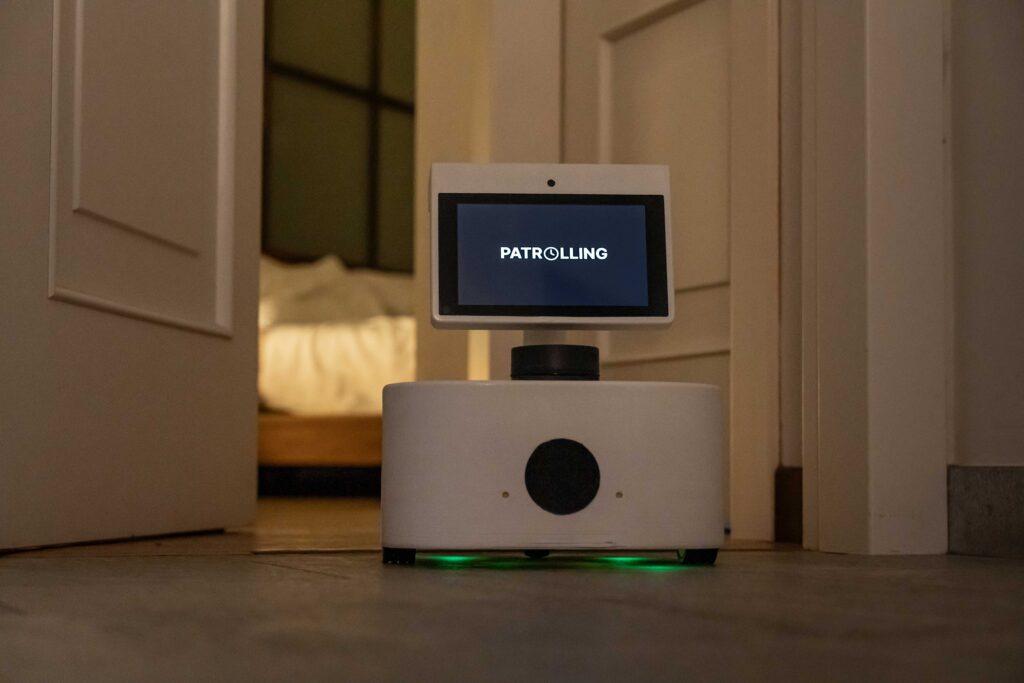
Future Makers program: Maker Days Eindhoven invests in the future

Friday, September 13th marks the kick-off day for Maker Days Eindhoven. The day begins with the launch of the Future Makers program in collaboration with the Novalis high school from Eindhoven, followed by Maker Night in the evening—a premiere of a mind-blowing experience featuring unique Sound Machines.
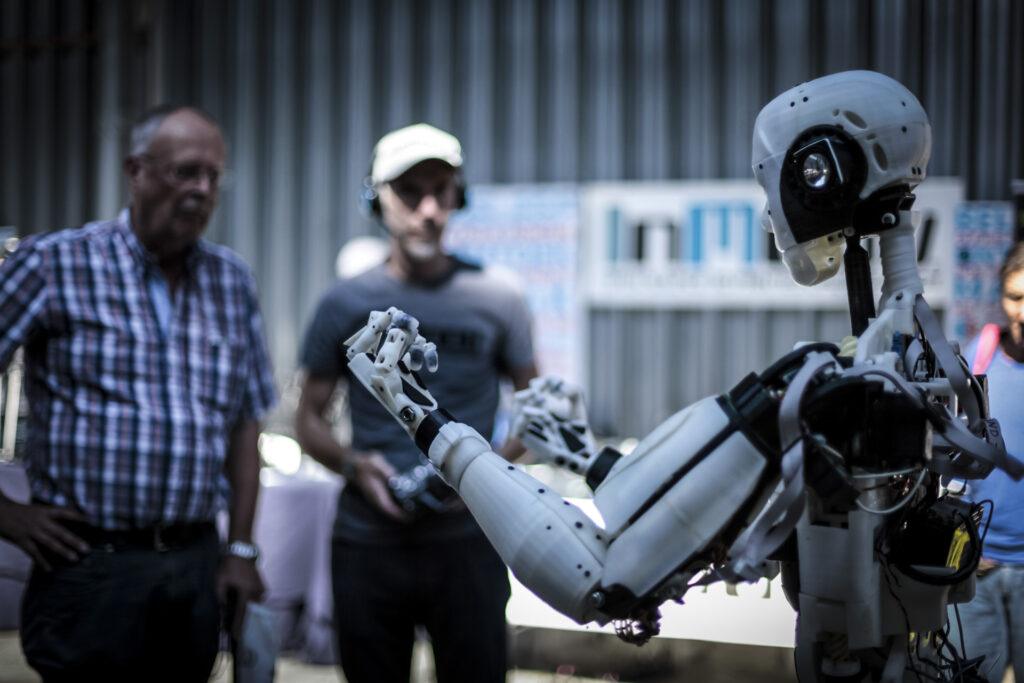
On Friday, September 13th, the Future Makers Factory will debut, a unique program aimed at young people, developed in collaboration with schools and partners. This day is all about innovation, technology, and creativity and serves as a significant lead-up to Maker Days Eindhoven, which will take place on Saturday, September 14th, and Sunday, September 15th.
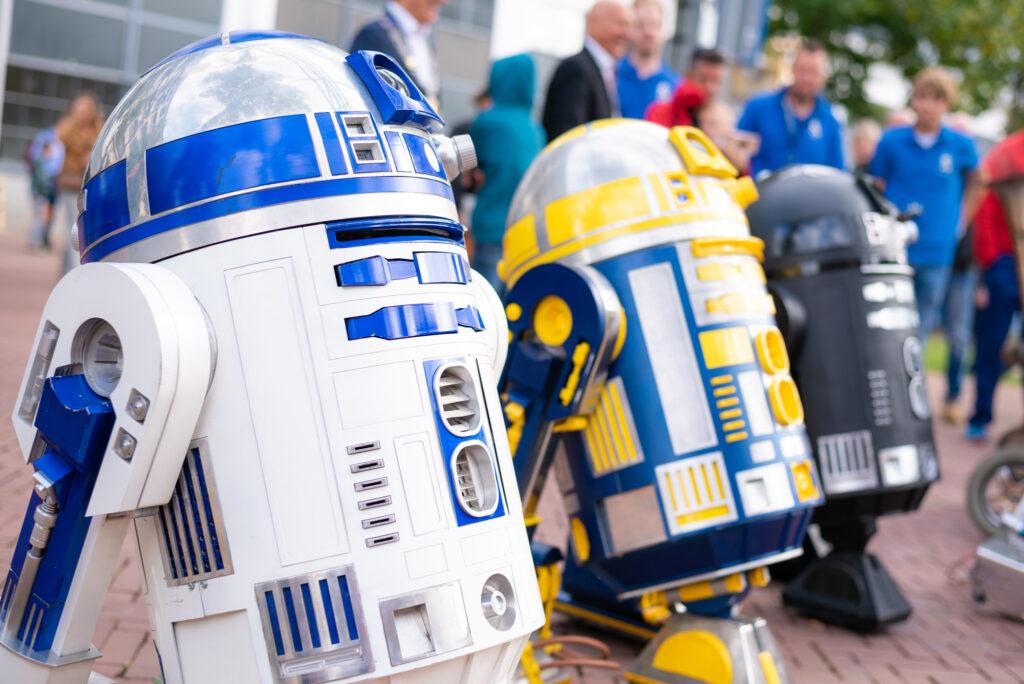
In the morning, the Maker Days organization will host four classes from Novalis high school in Eindhoven for an inspiring and educational program. Students will participate in various workshops designed to challenge and inspire them to discover and develop their own creativity. The workshops focus on themes such as Sound Machines, virtual reality, the metaverse, video, music, upcycling, sustainable living, kinetic art, cyber fashion, gaming, transformer, and robot art.

The Future Makers Factory is not just an event; it is a powerful statement promoting creative technology and the development of 21st-century skills. As a side event of Maker Days Eindhoven, this program puts maker education firmly on the map, offering young people aged 14 to 25 the chance to discover and develop their talents.

The kick-off day continues into the evening, where all youth under the age of 23 are invited. Maker Night is a special performance program developed specifically for this age group. During this evening, they can enjoy spectacular and interactive performances, a perfect way to conclude a day full of innovation. Tickets for this evening are available at makerdays.nl.
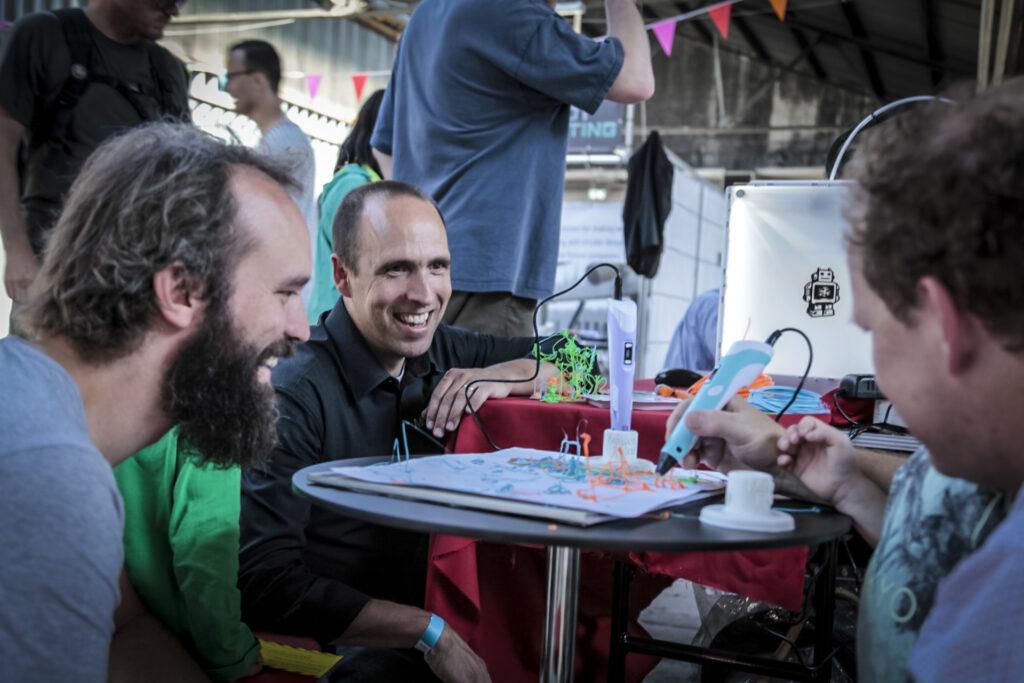
Zukunftsweisende MINT-Bildung mit der neuen senseBox:edu S2
Die senseBox ist ein Toolkit für digitale Bildung, Citizen Science und Umweltmonitoring und wurde vom Start-Up re:edu gemeinsam mit dem Institut für Geoinformatik der Universität Münster entwickelt. Dabei wurde die senseBox:edu speziell für den Bildungsbereich konzipiert.
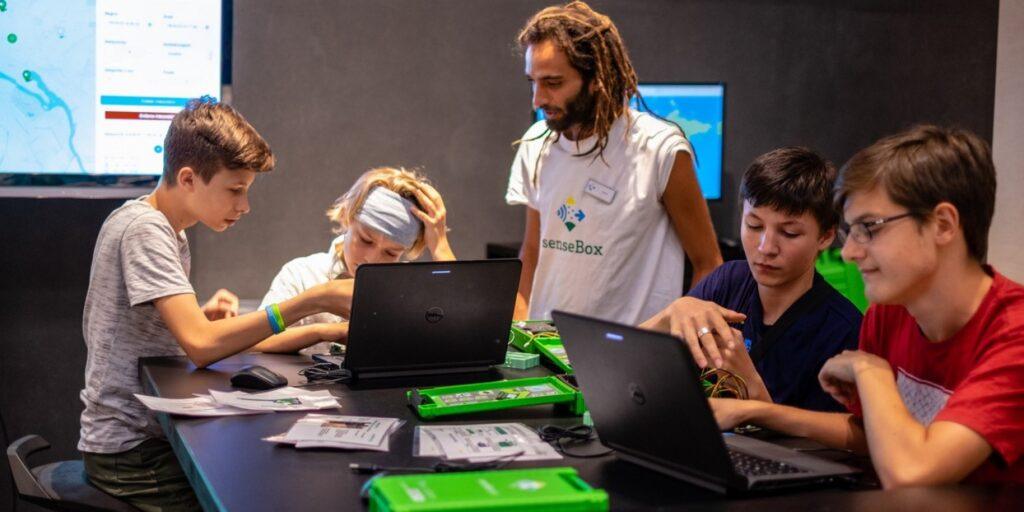
Neben der Hardware stehen die grafische Programmieroberfläche ‚Blockly für senseBox’ (https://blockly.sensebox.de) sowie Lehr- und Lernmaterialien (https://sensebox.de/de/material) und Projekte (https://sensebox.de/de/projects) als OER (Open Educational Resource) frei zur Verfügung. Die senseBox kann auch in CircuitPhython programmiert werden!
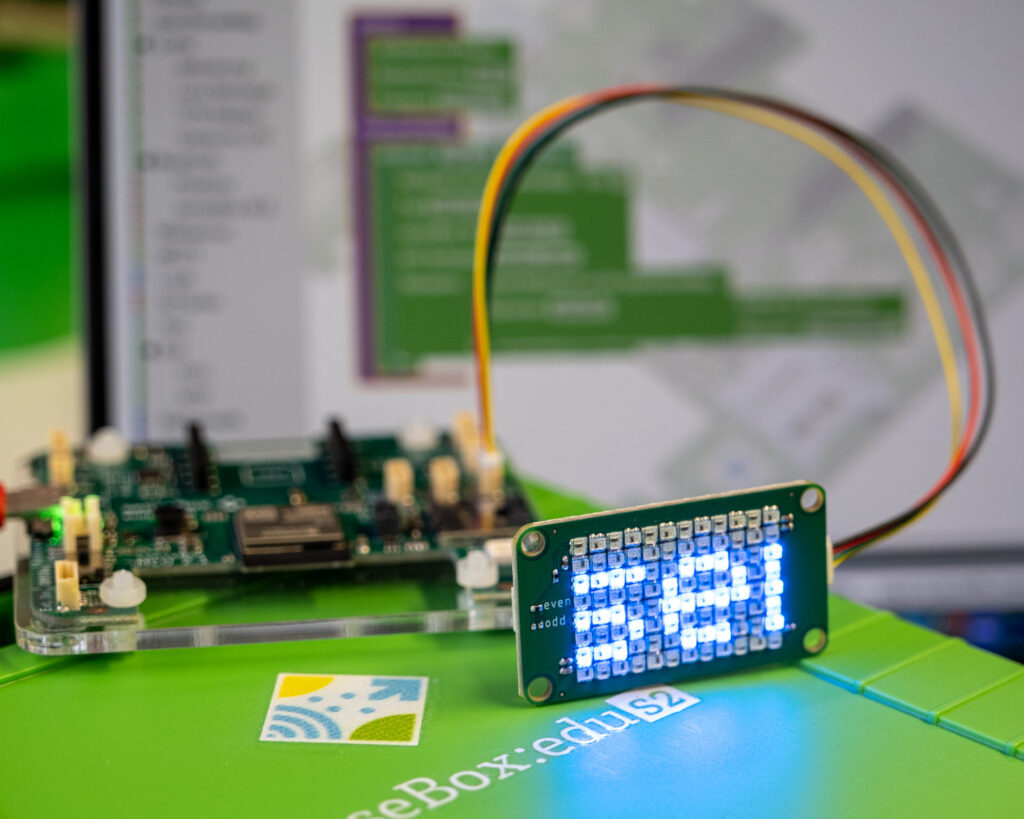
Die senseBox:edu S2 ist das neueste Mitglied der senseBox-Familie und richtet sich wie ihr Vorgänger an Bildungsinstitutionen, die Lernenden praxisorientierte Einblicke in die Welt der Programmierung gibt und die Bereiche Umwelt und Technik anwendungsbezogen verknüpft. Die senseBox:edu S2 bietet viele neue Features:
Der neue MCU S2 Mikrocontroller hat im Vergleich zur MCU viele Komponenten direkt auf dem Board integriert, wie eine RGB-LED, einen Lichtsensor, ein Bluetooth-Bee zur Verwendung mit der Phyphox-App (https://phyphox.org/de/home-de/), einen Beschleunigungssensor sowie Gyroskop (je 3-Achsen), einen Akkuladeregler für eine unkomplizierte und zuverlässige Stromversorgung sowie W-LAN und ein mSD-Kartenmodul zur Datenspeicherung. Des Weiteren enthält er einen schnelleren Prozessor mit mehr Speicher und Qwiic-kompatible Ports. Außerdem enthält die senseBox:edu S2 neue Sensoren: Neben einer LED-Matrix zur farblichen Darstellung und zur Vermittlung weiterer Konzepte aus der Informatik (z.B. Arrays) ist ein Time-of-Flight (ToF)-Sensor enthalten, der sehr präzise Distanzen messen und ein einfaches 8×8 Pixel Bild erzeugen kann.
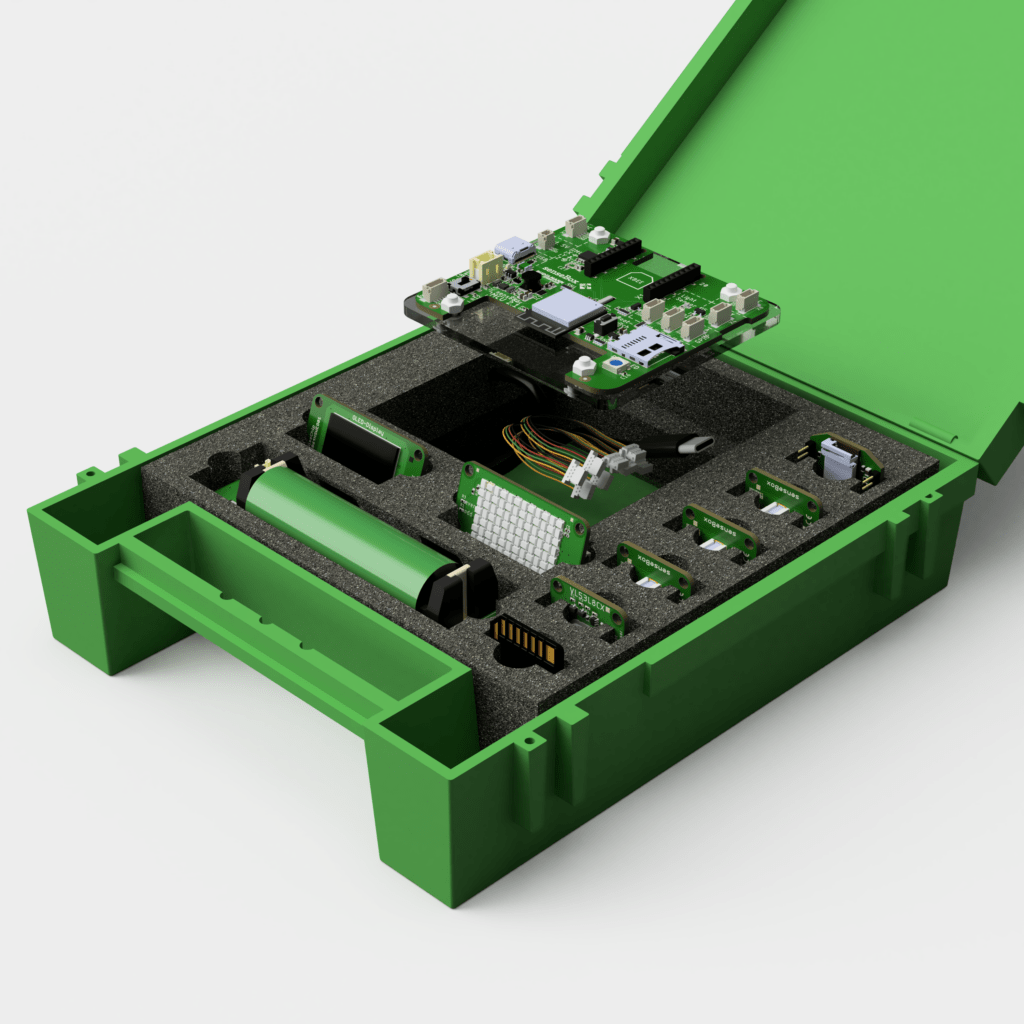
Ein weiteres Feature ist ESP Now zur direkten Kommunikation zwischen mehreren MCUs S2.
Neugierig geworden? Weitere Infos zur senseBox:edu S2 findet ihr unter
